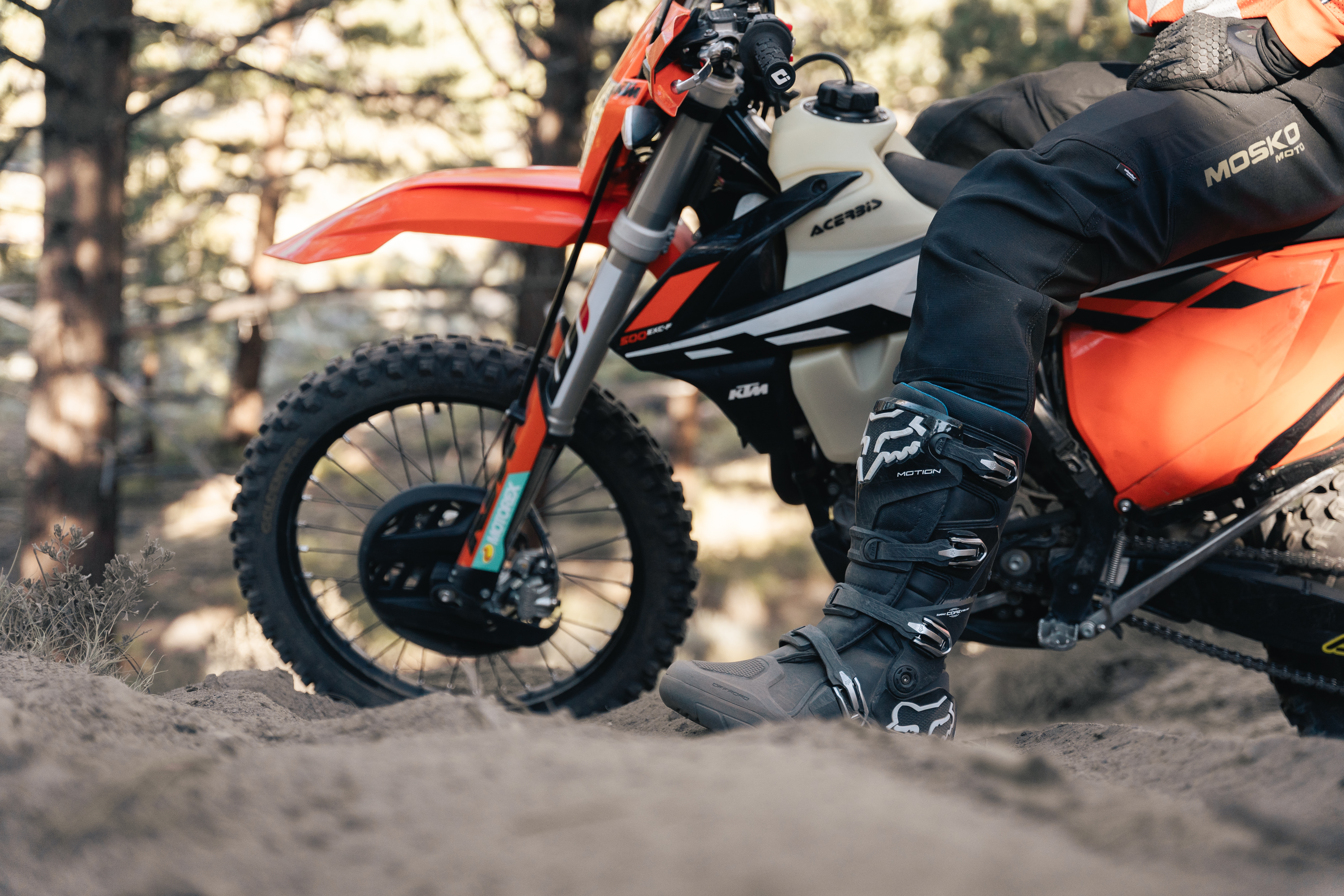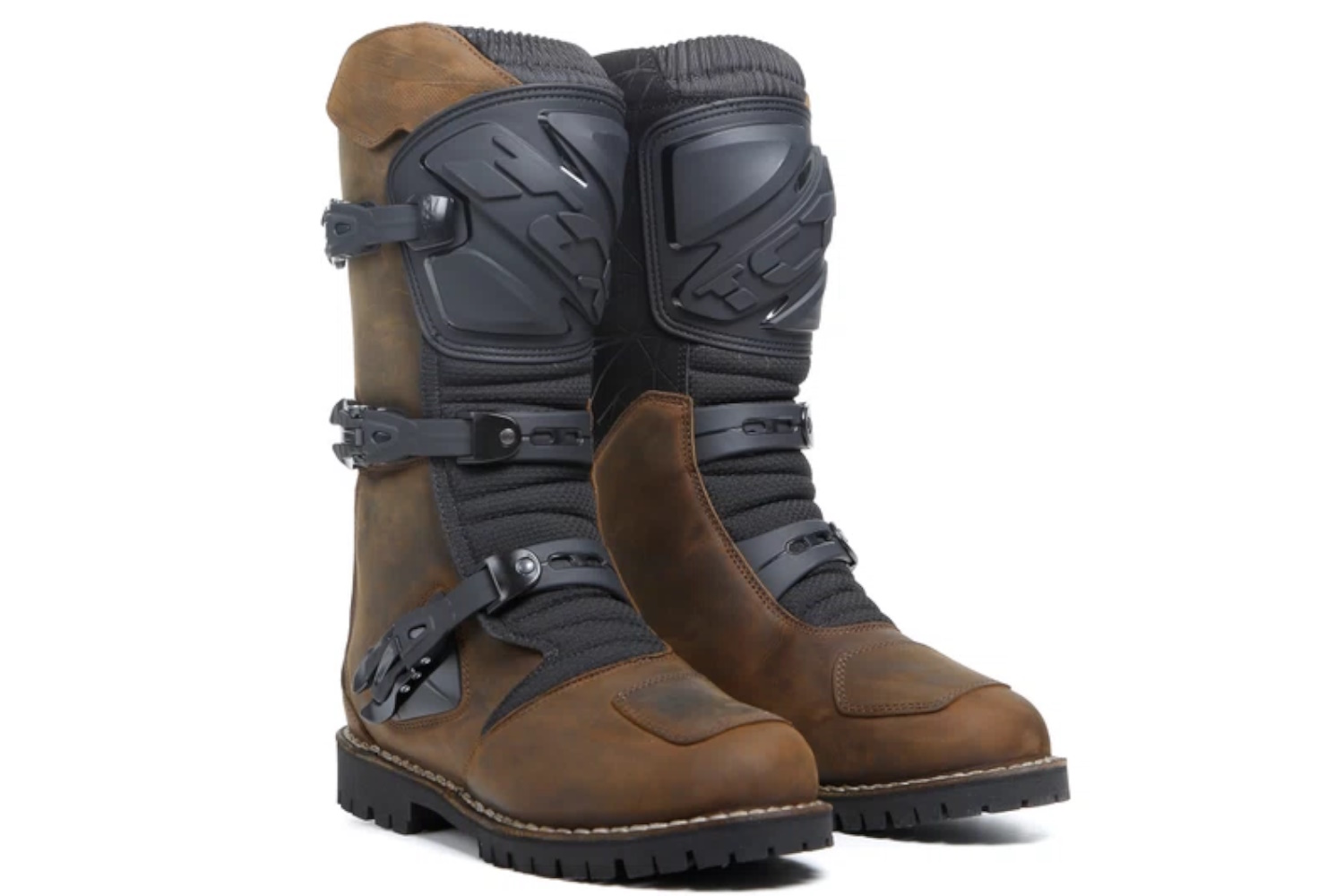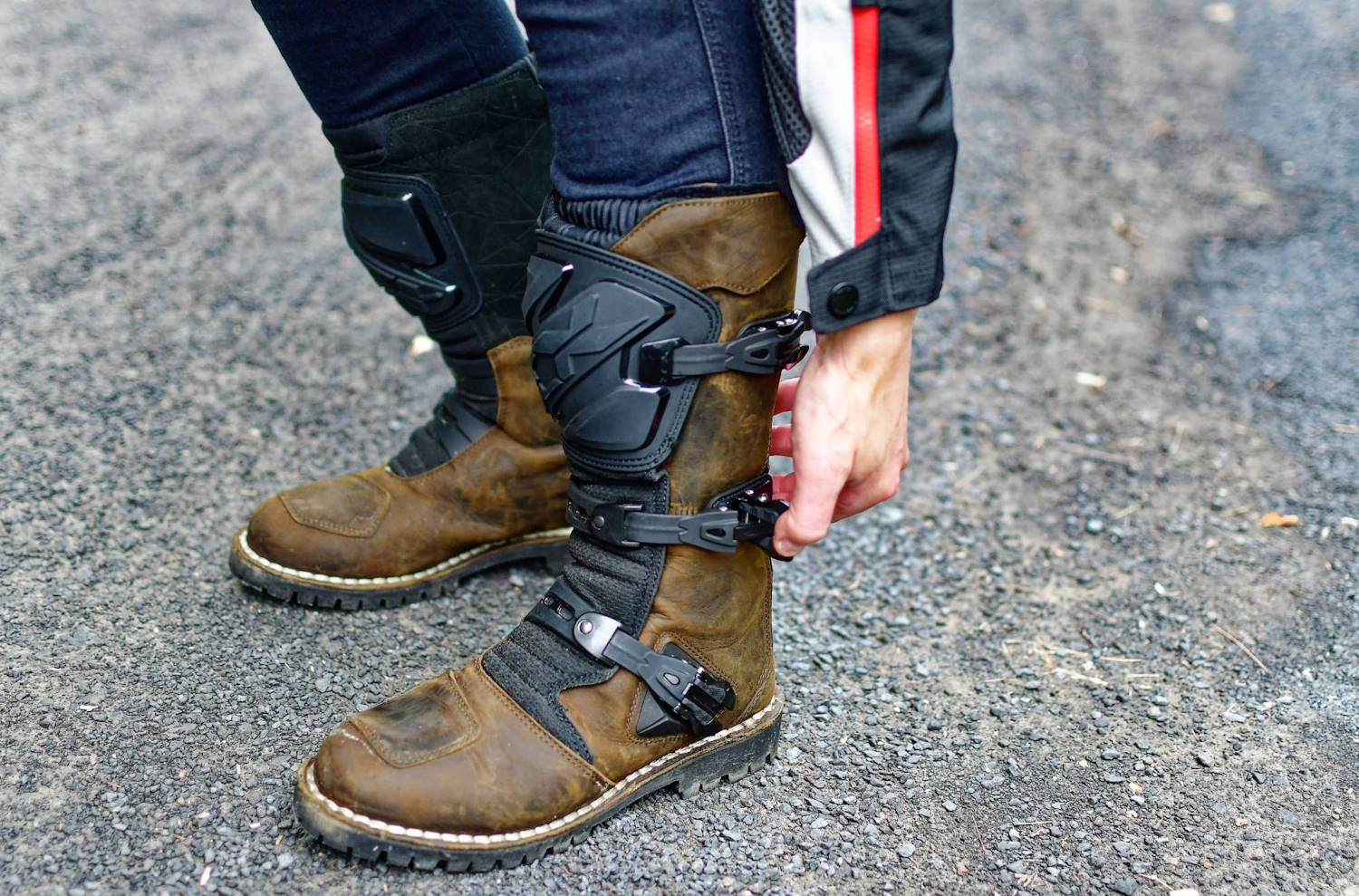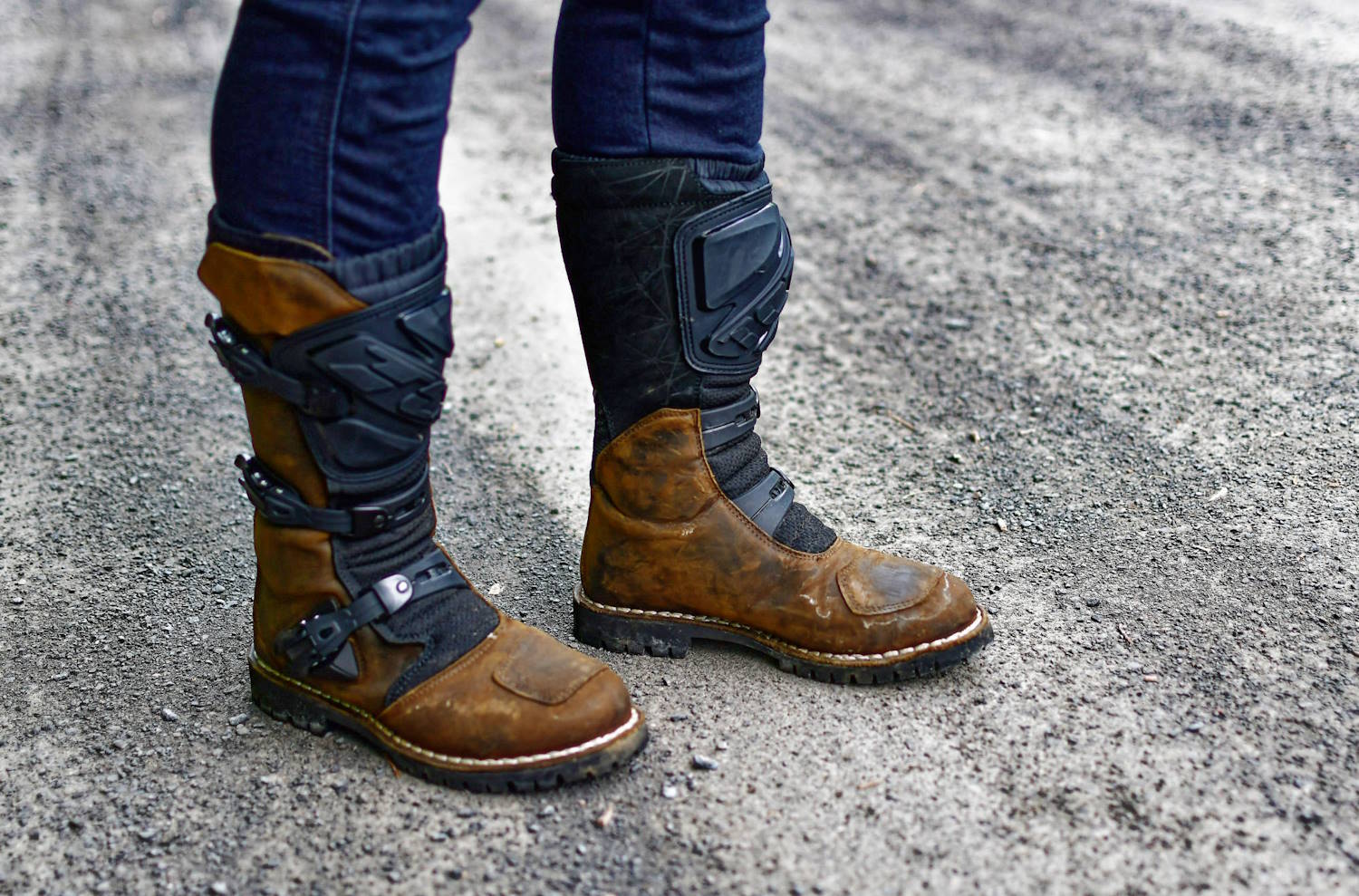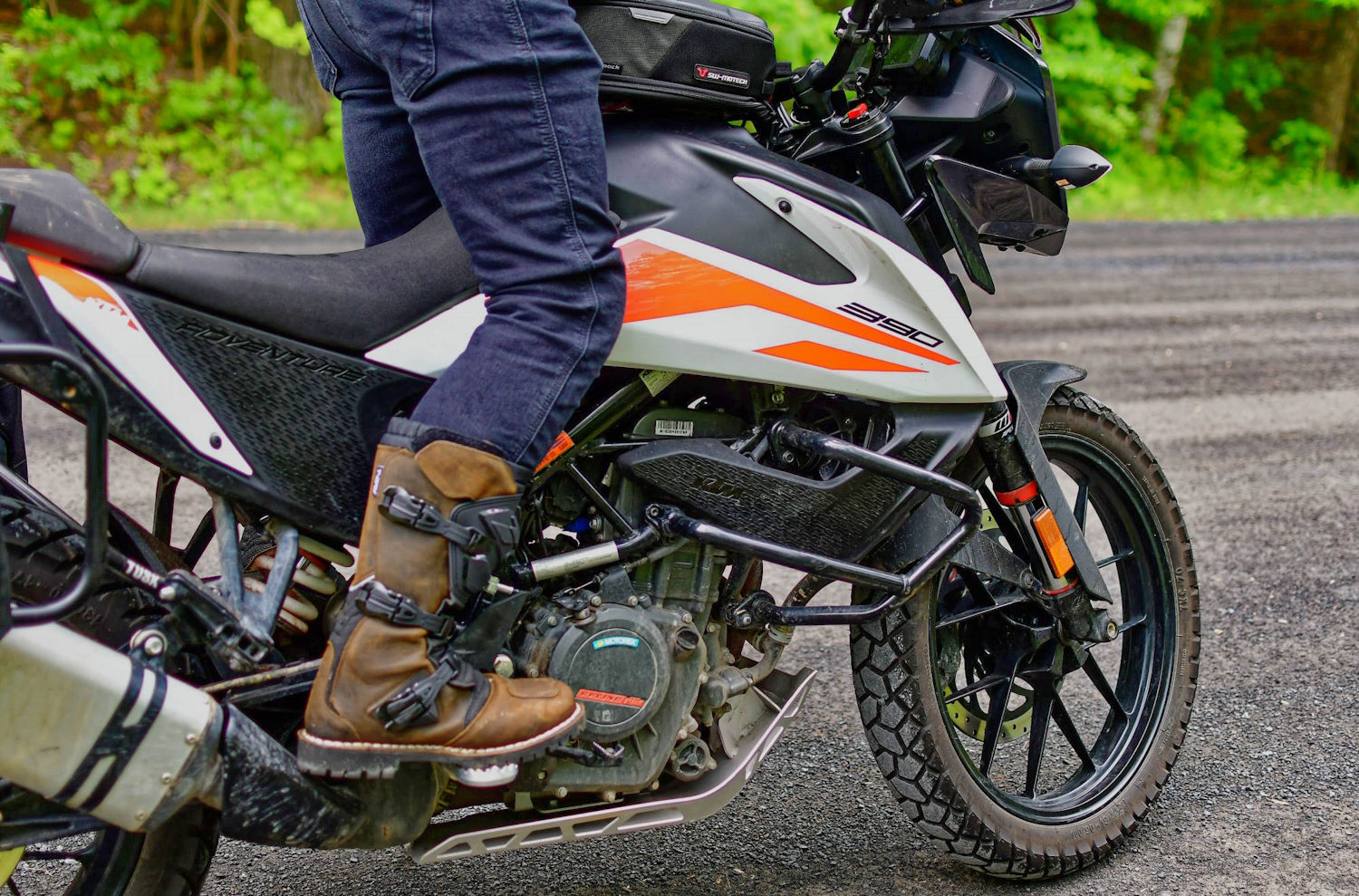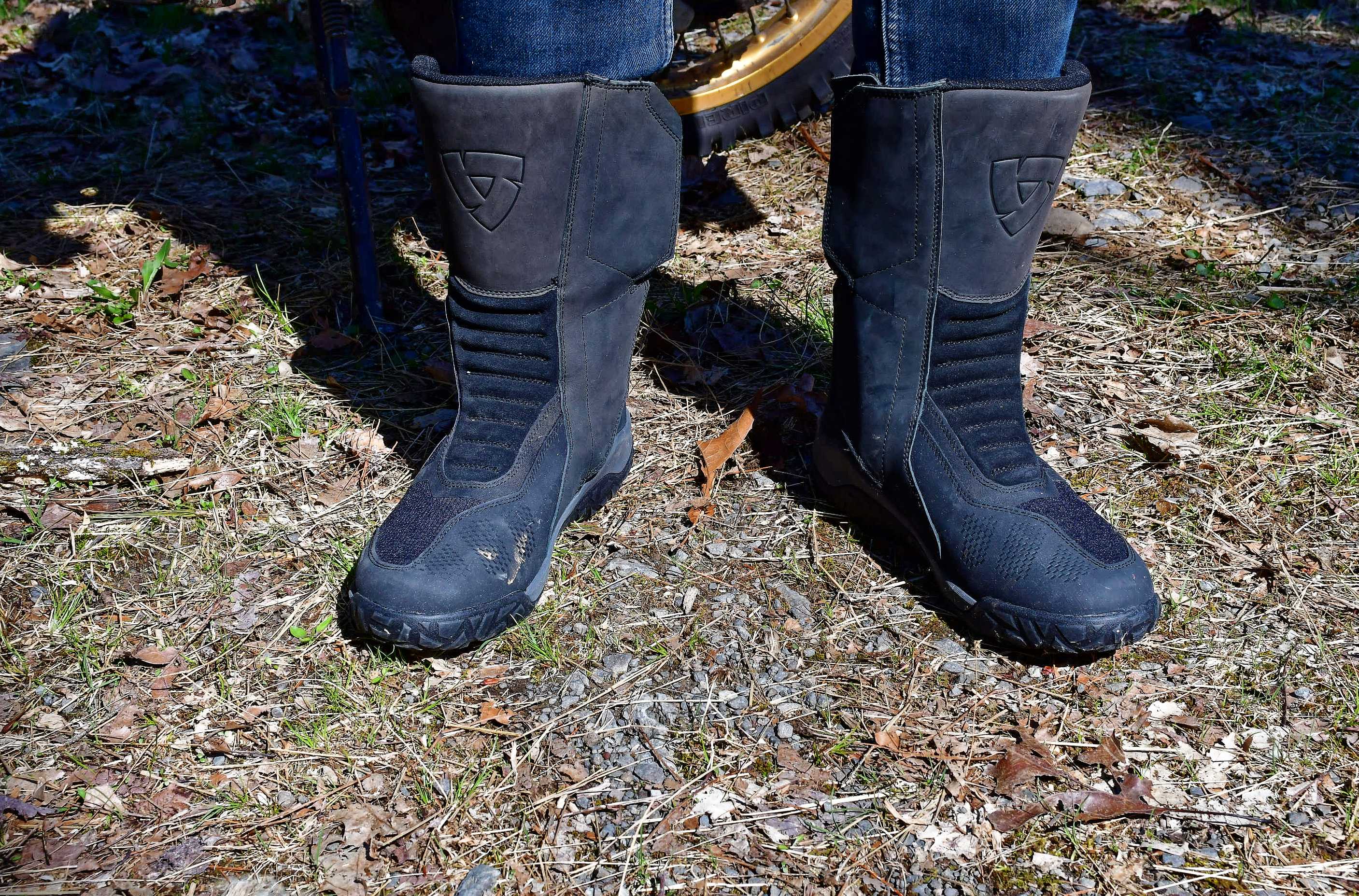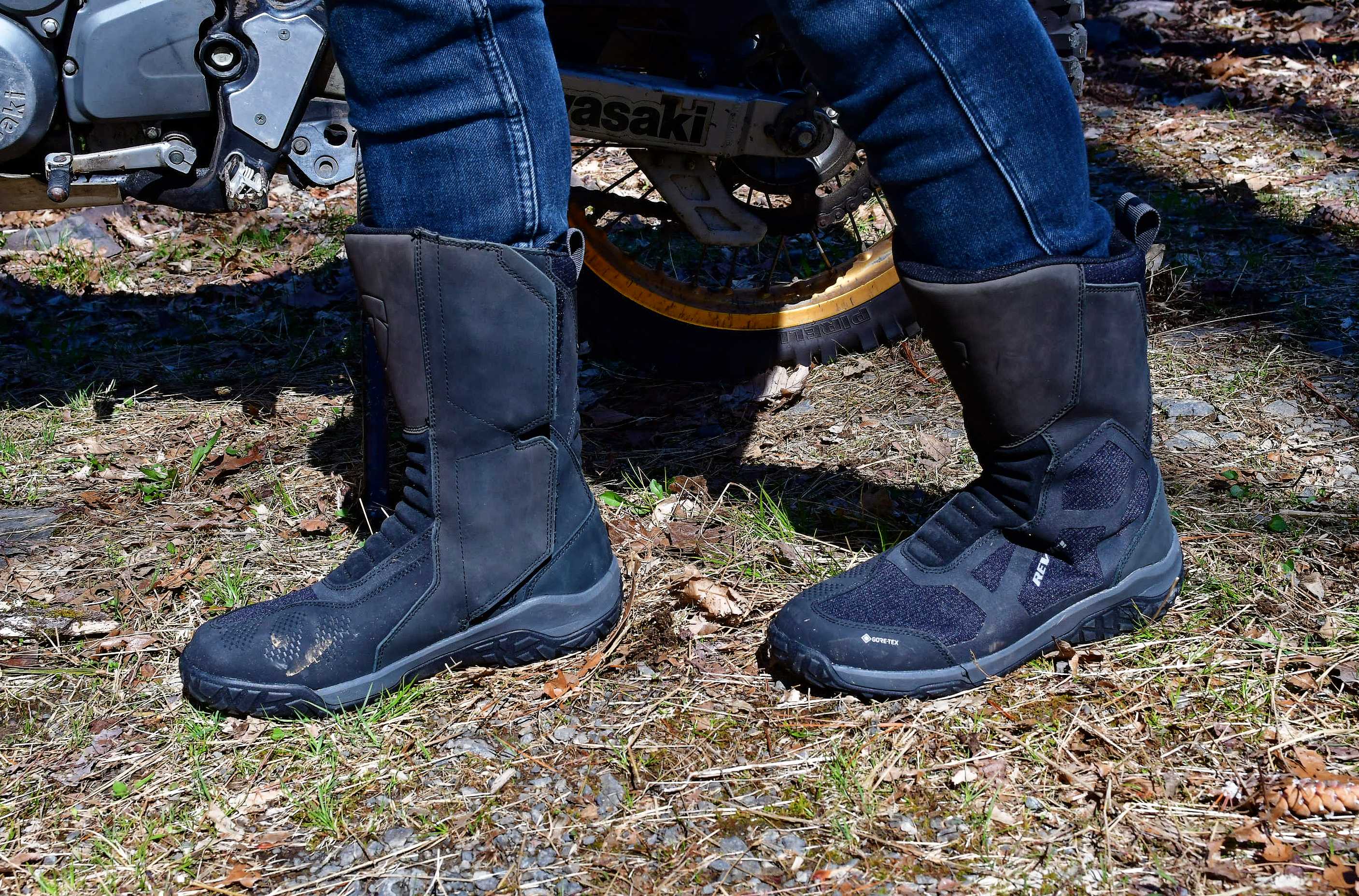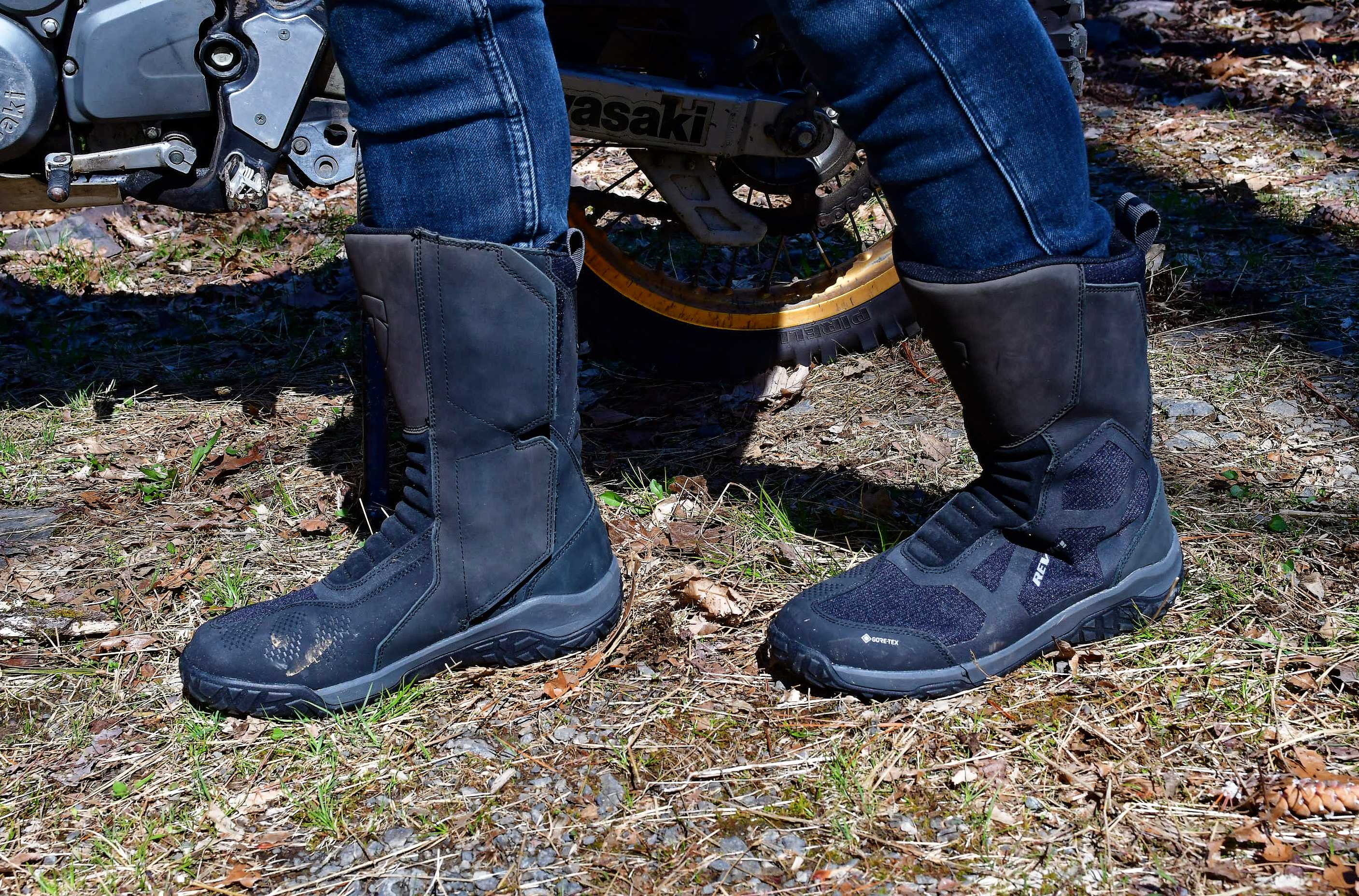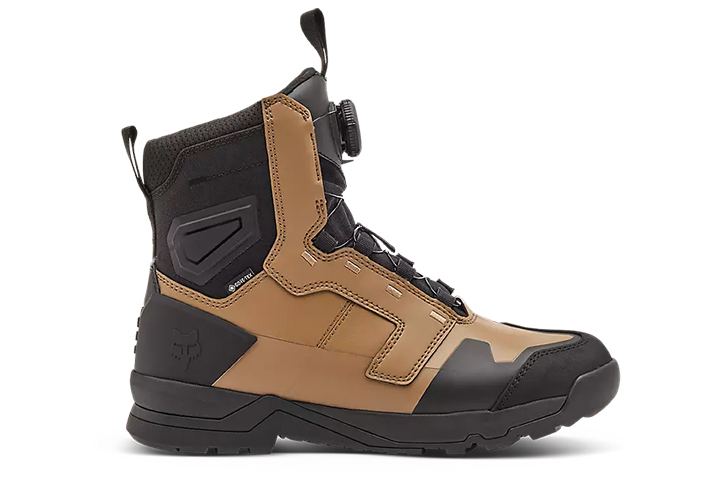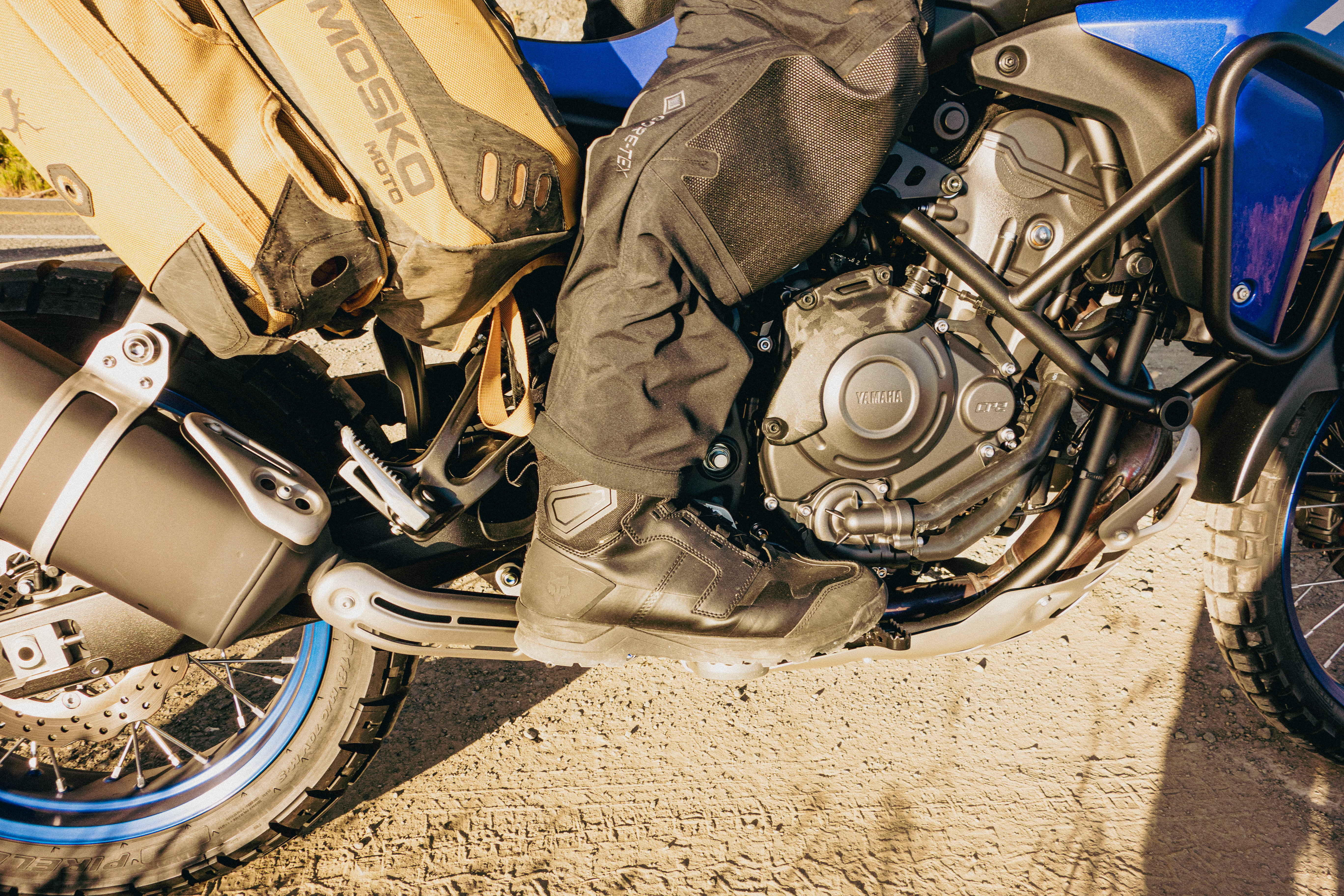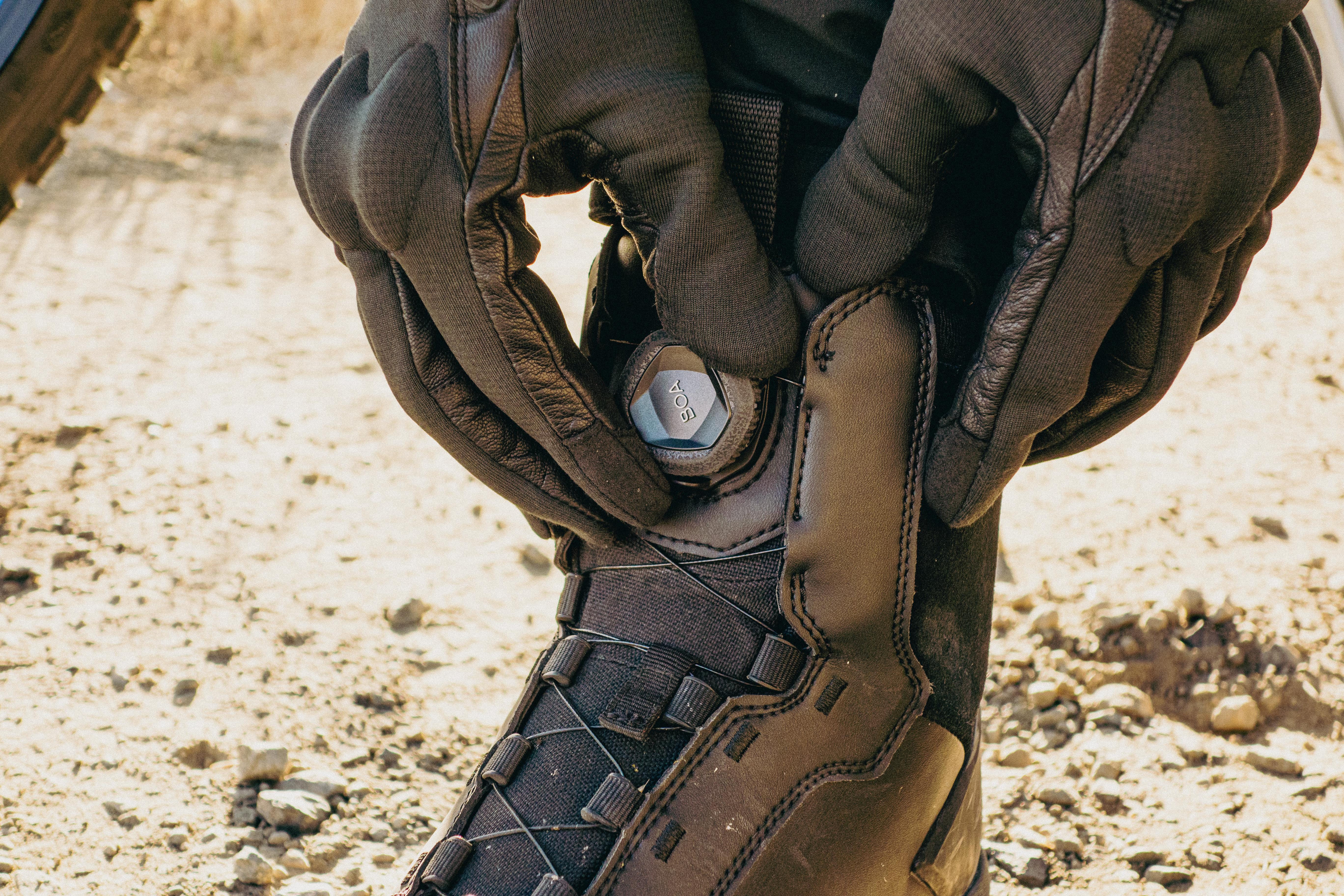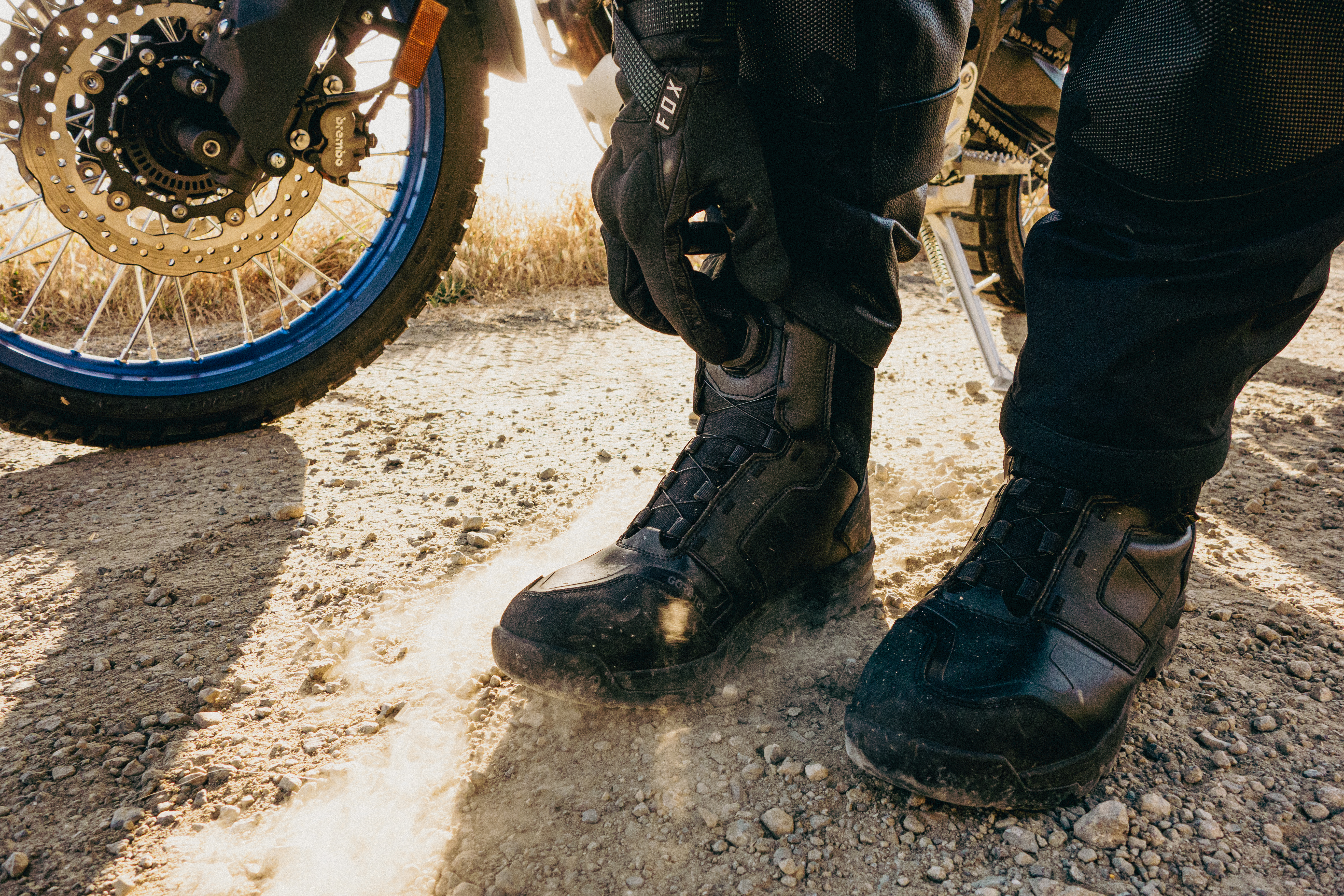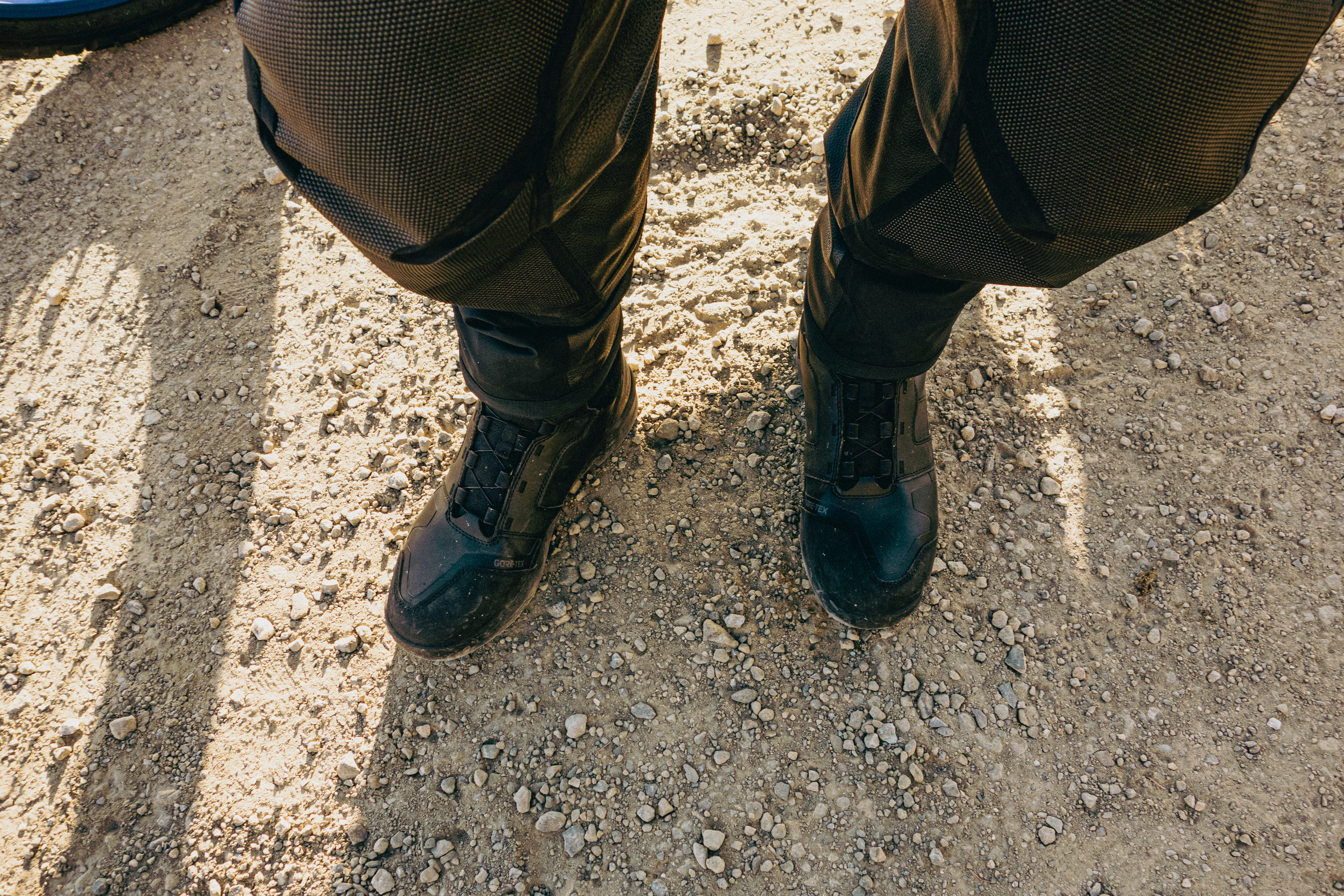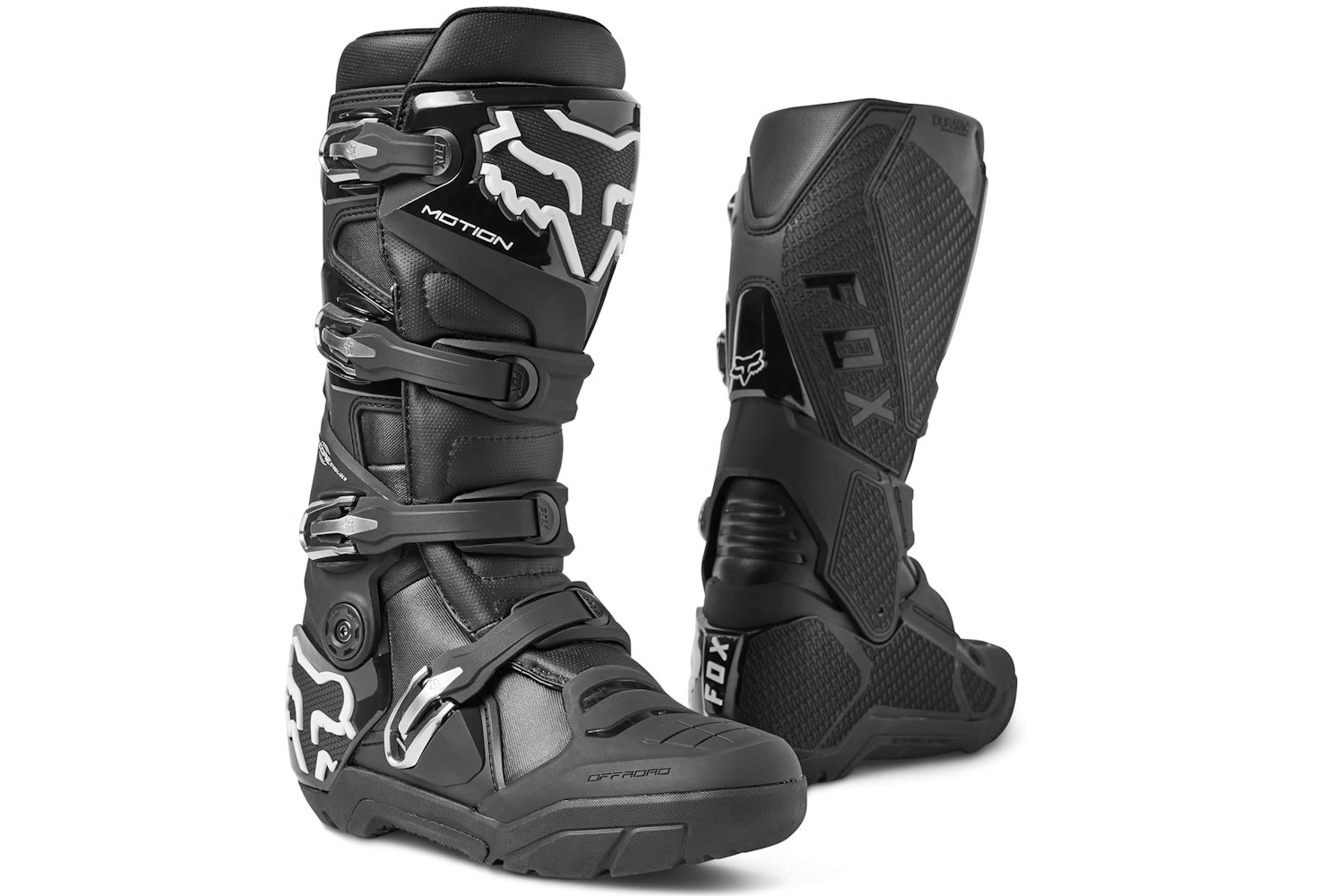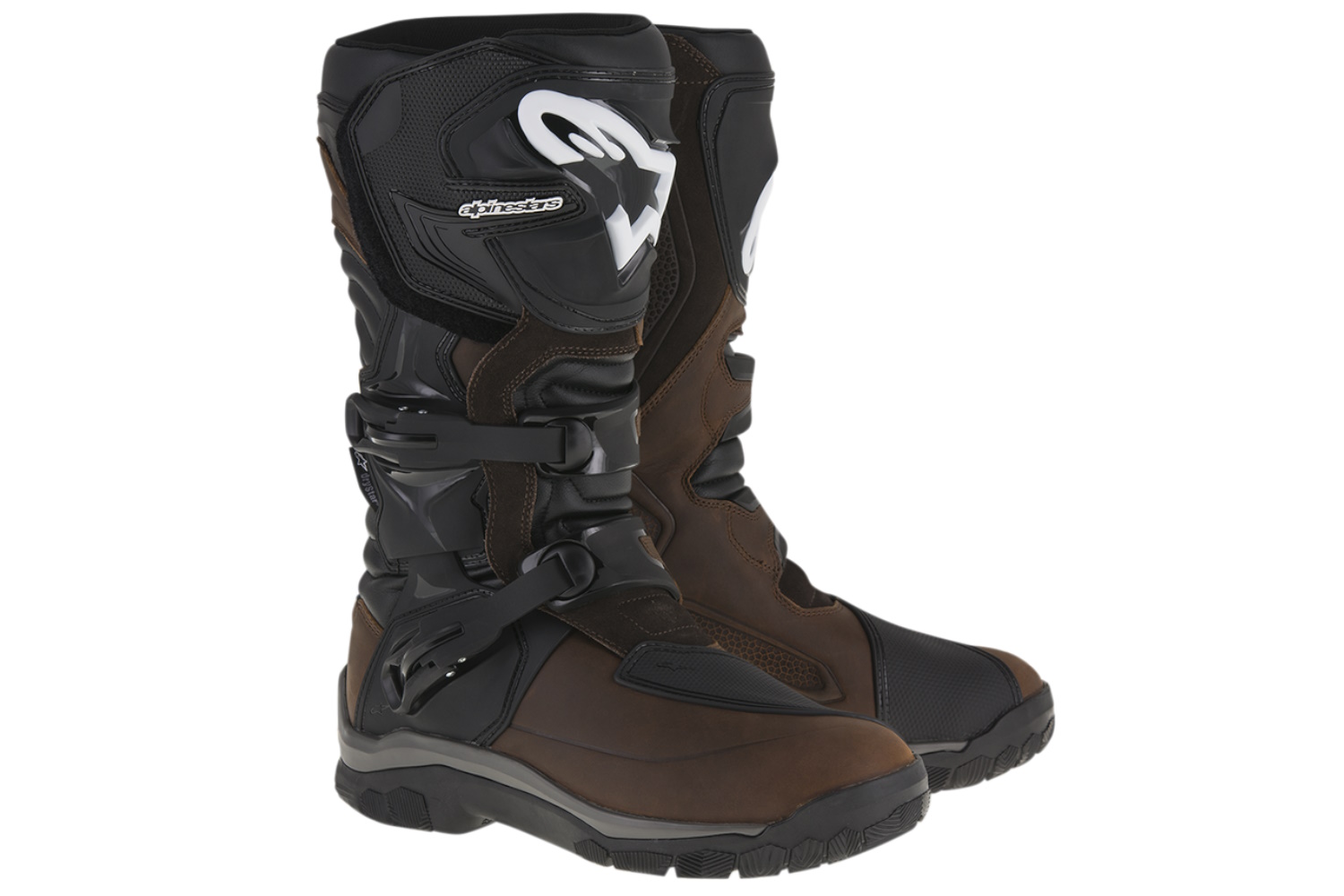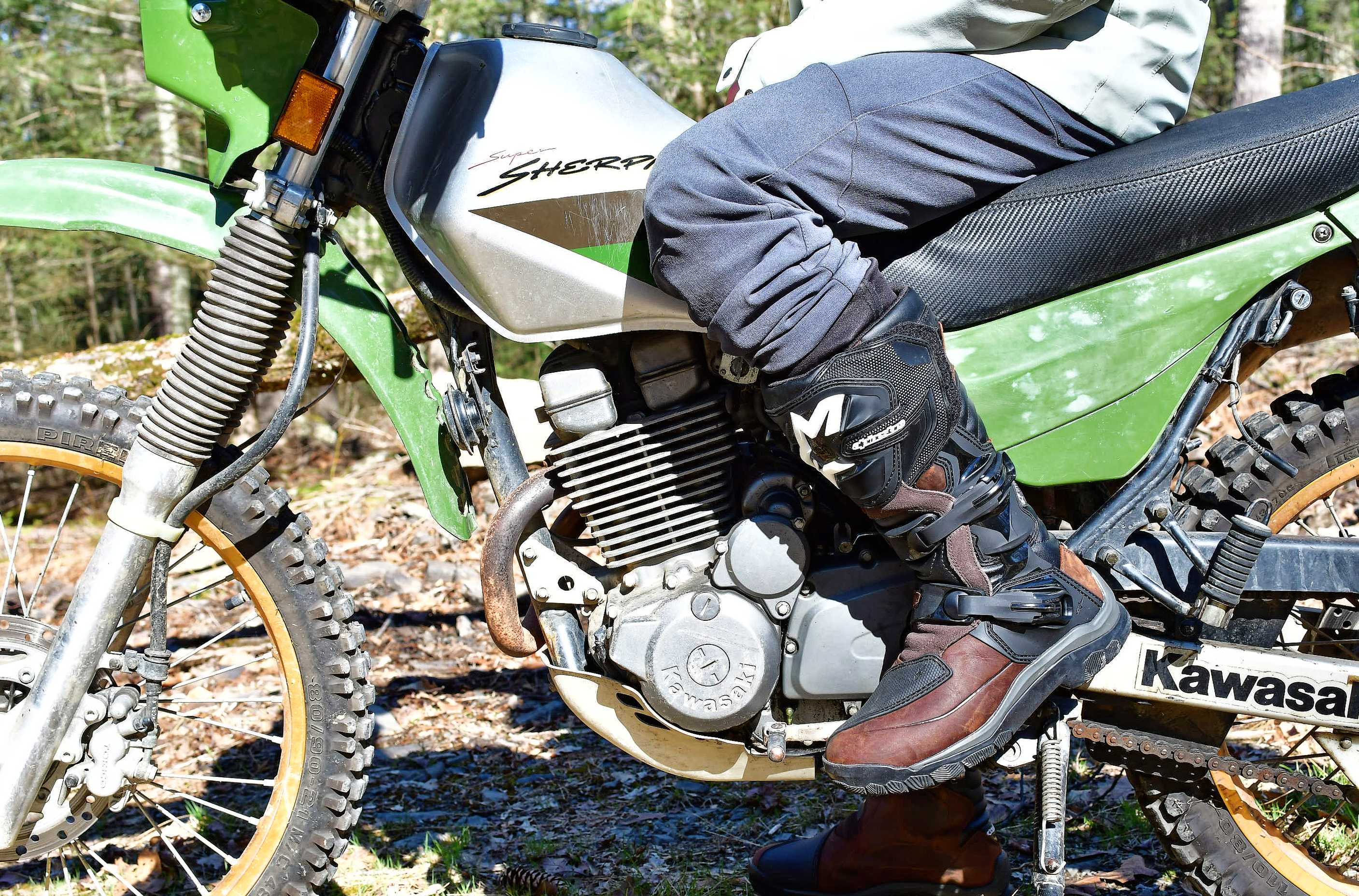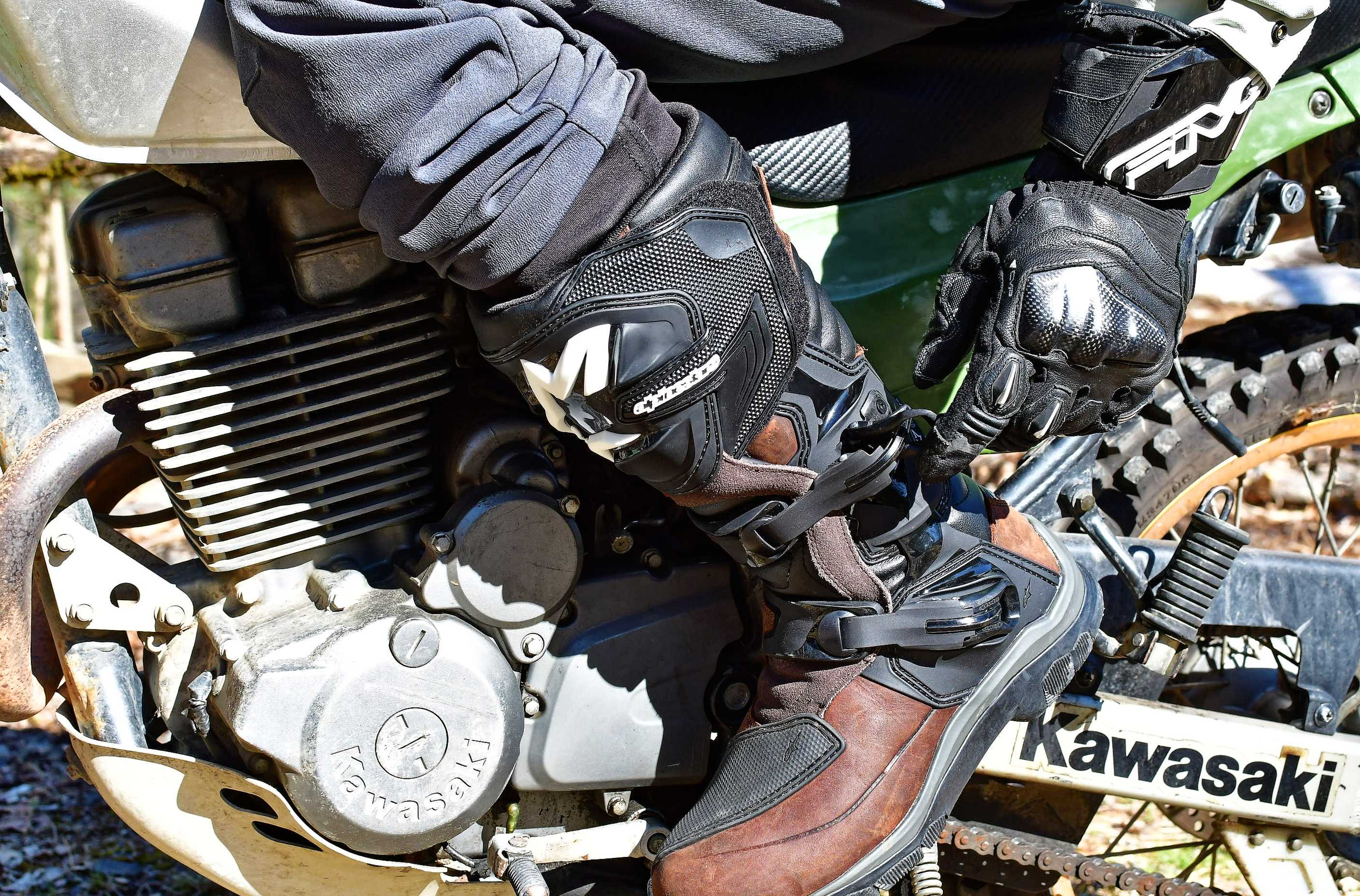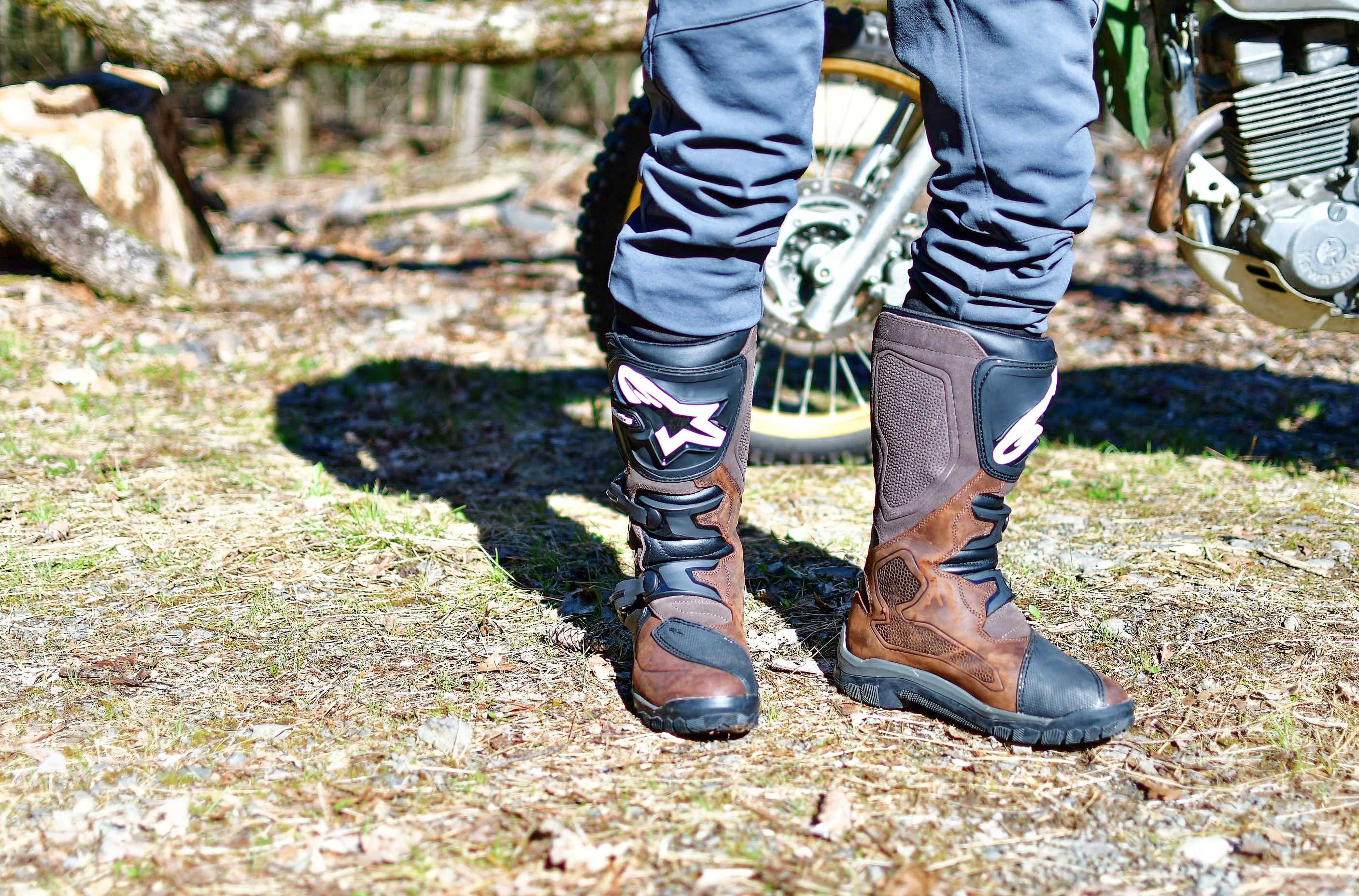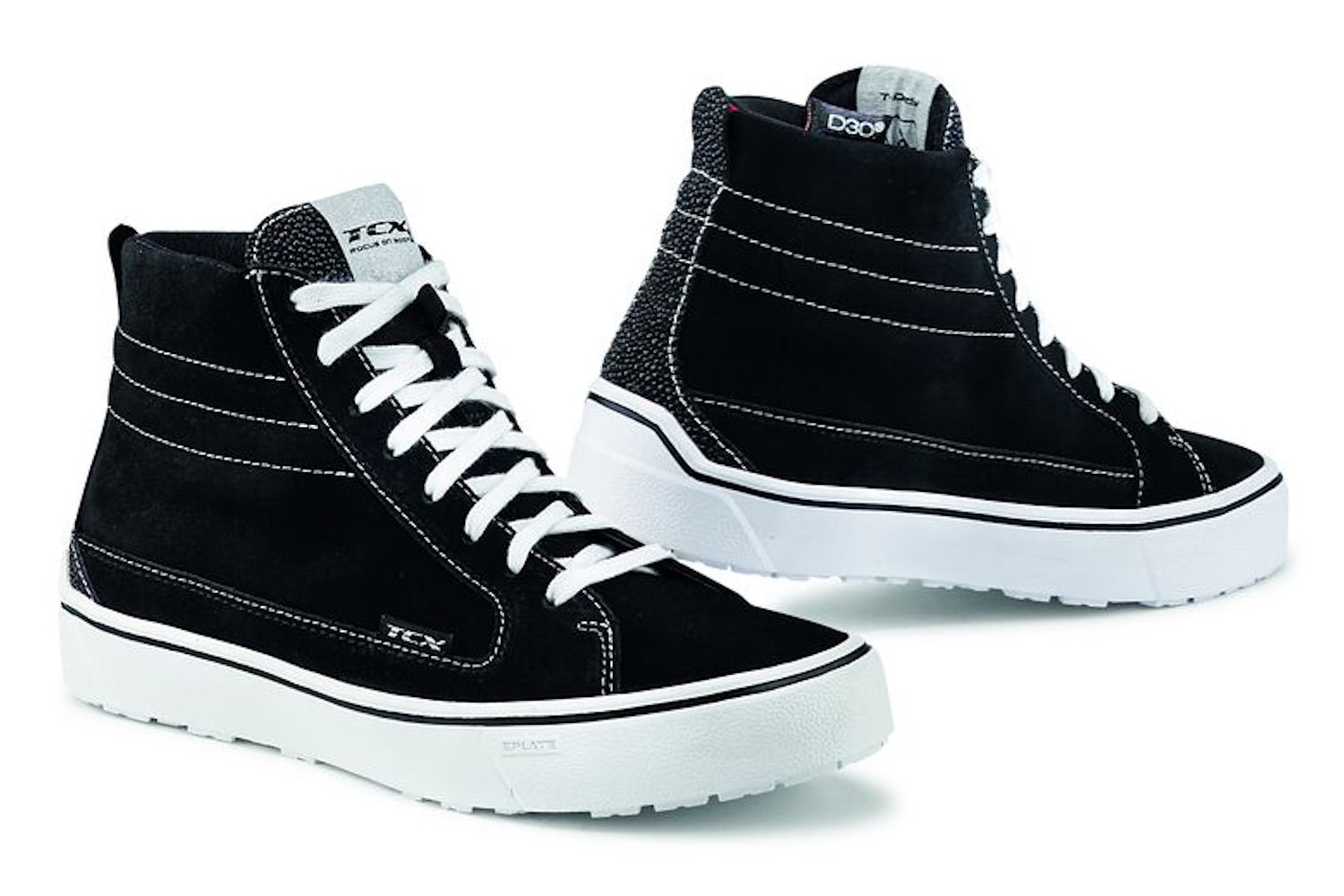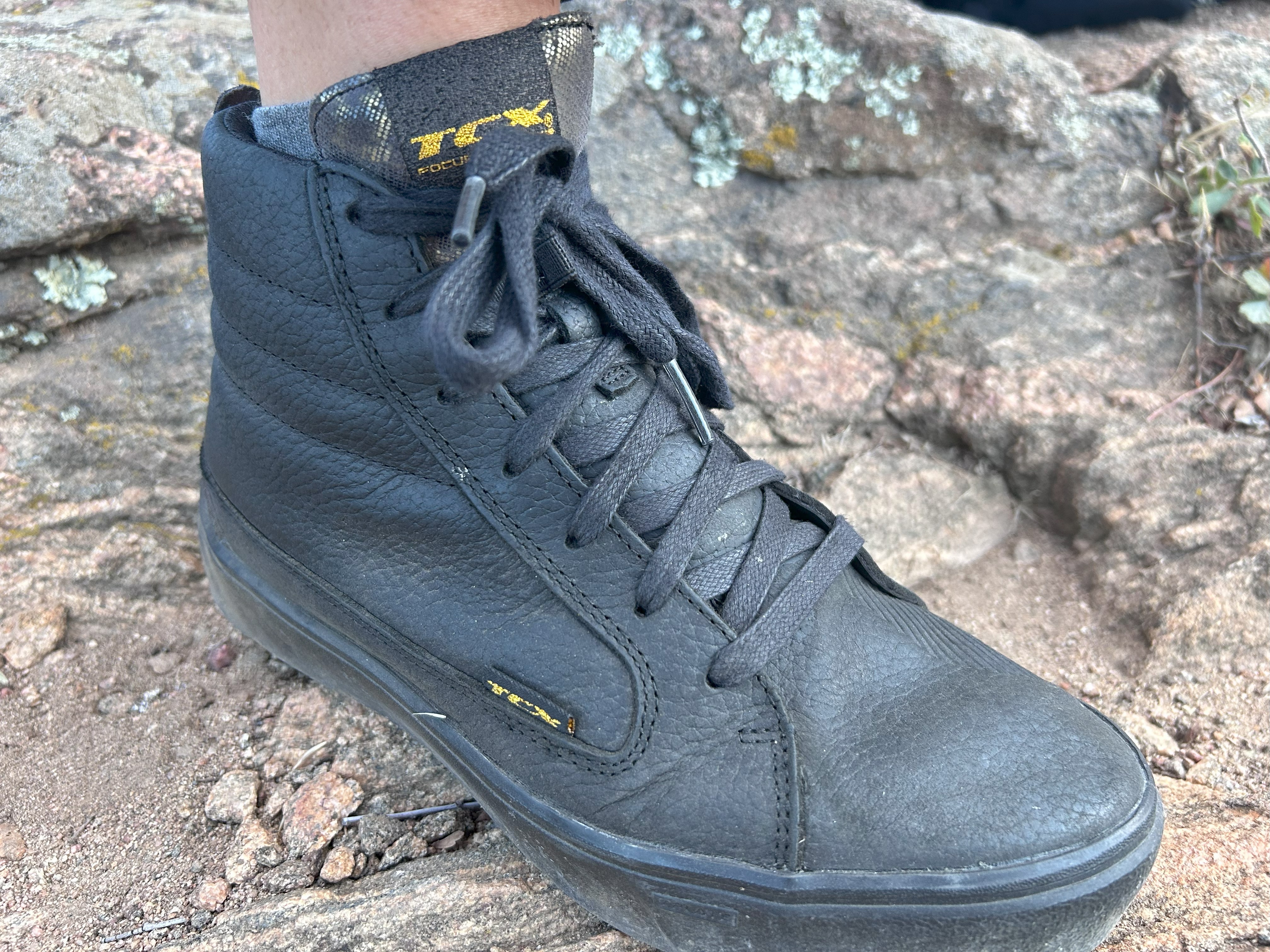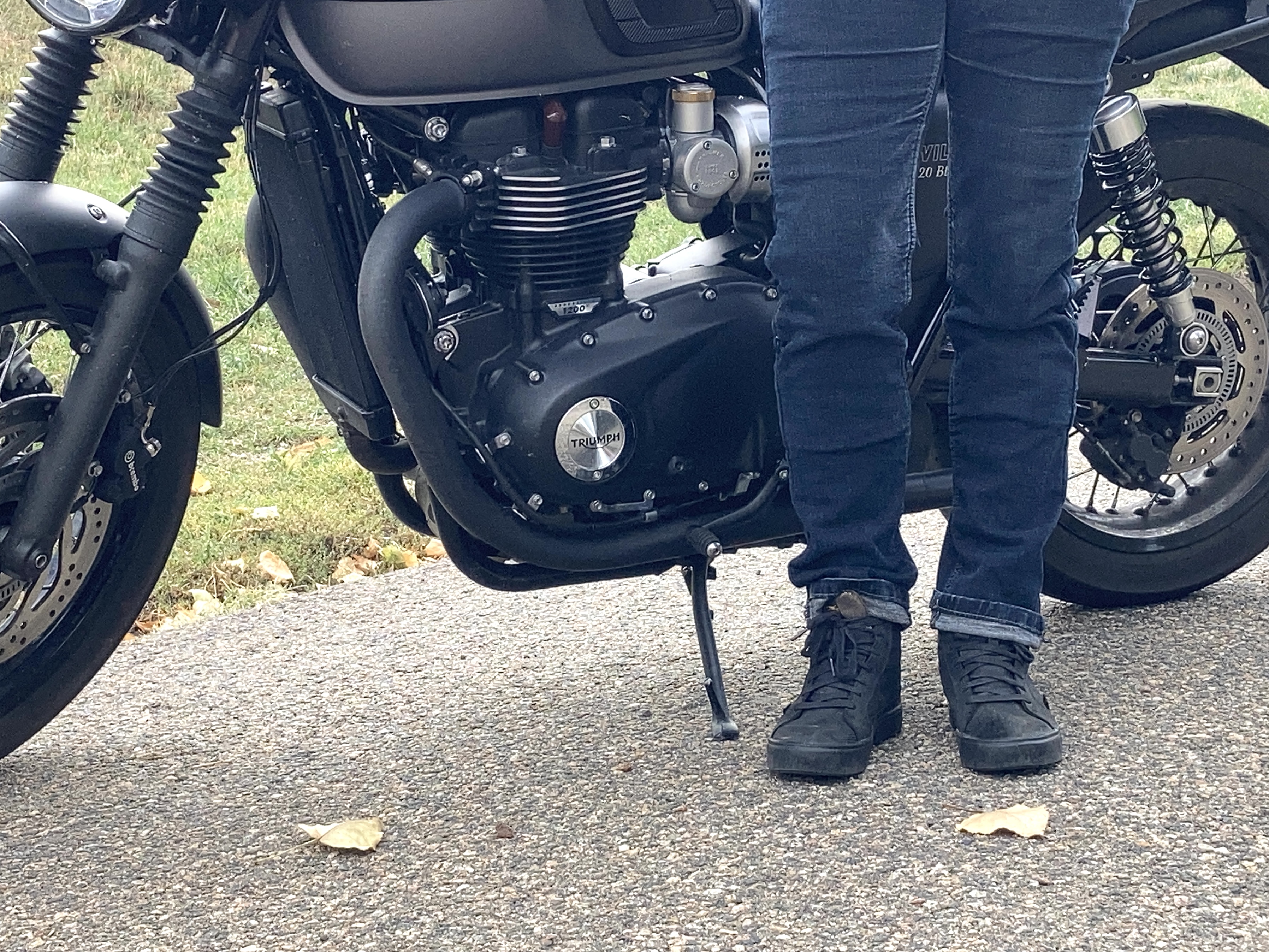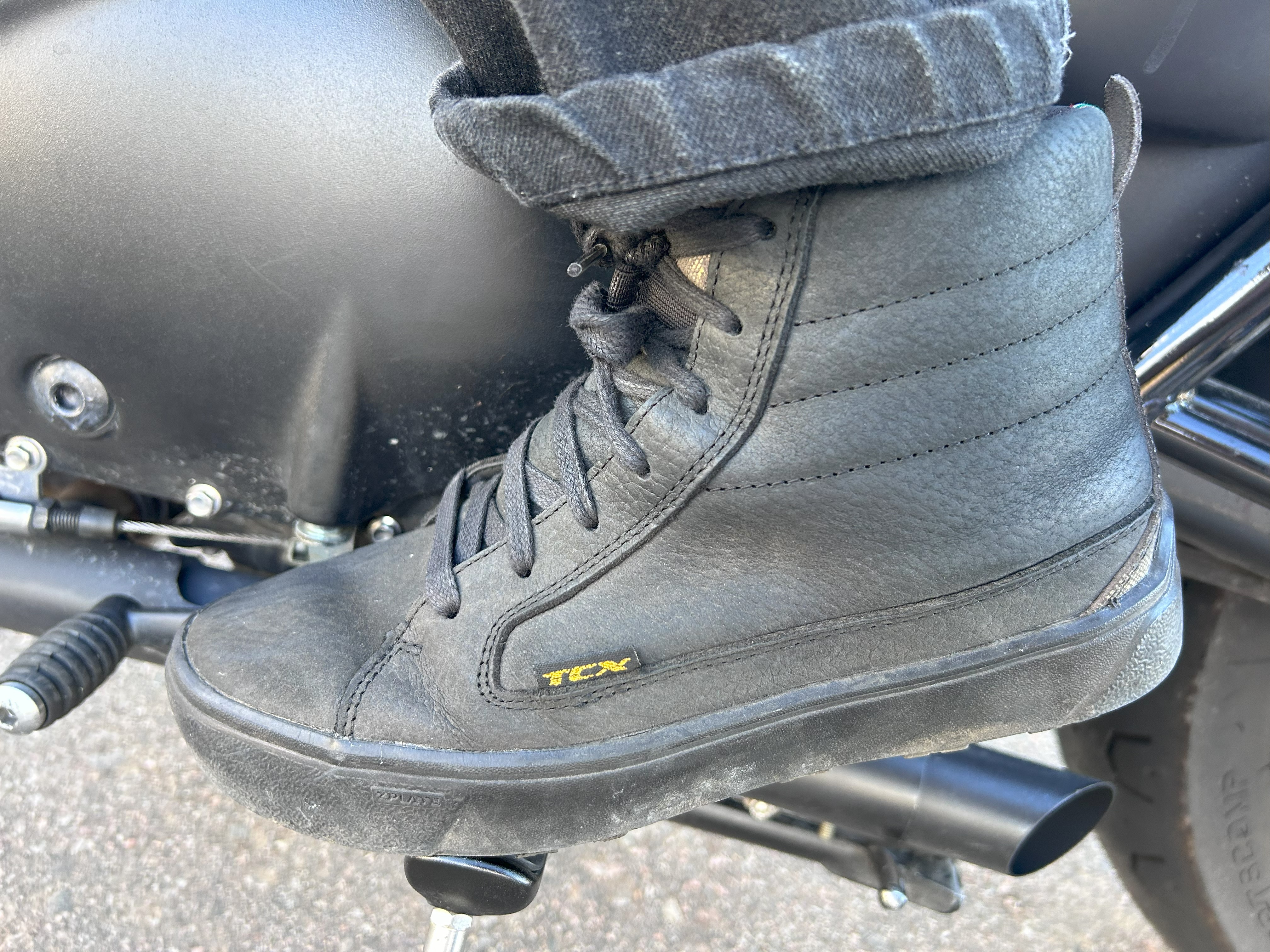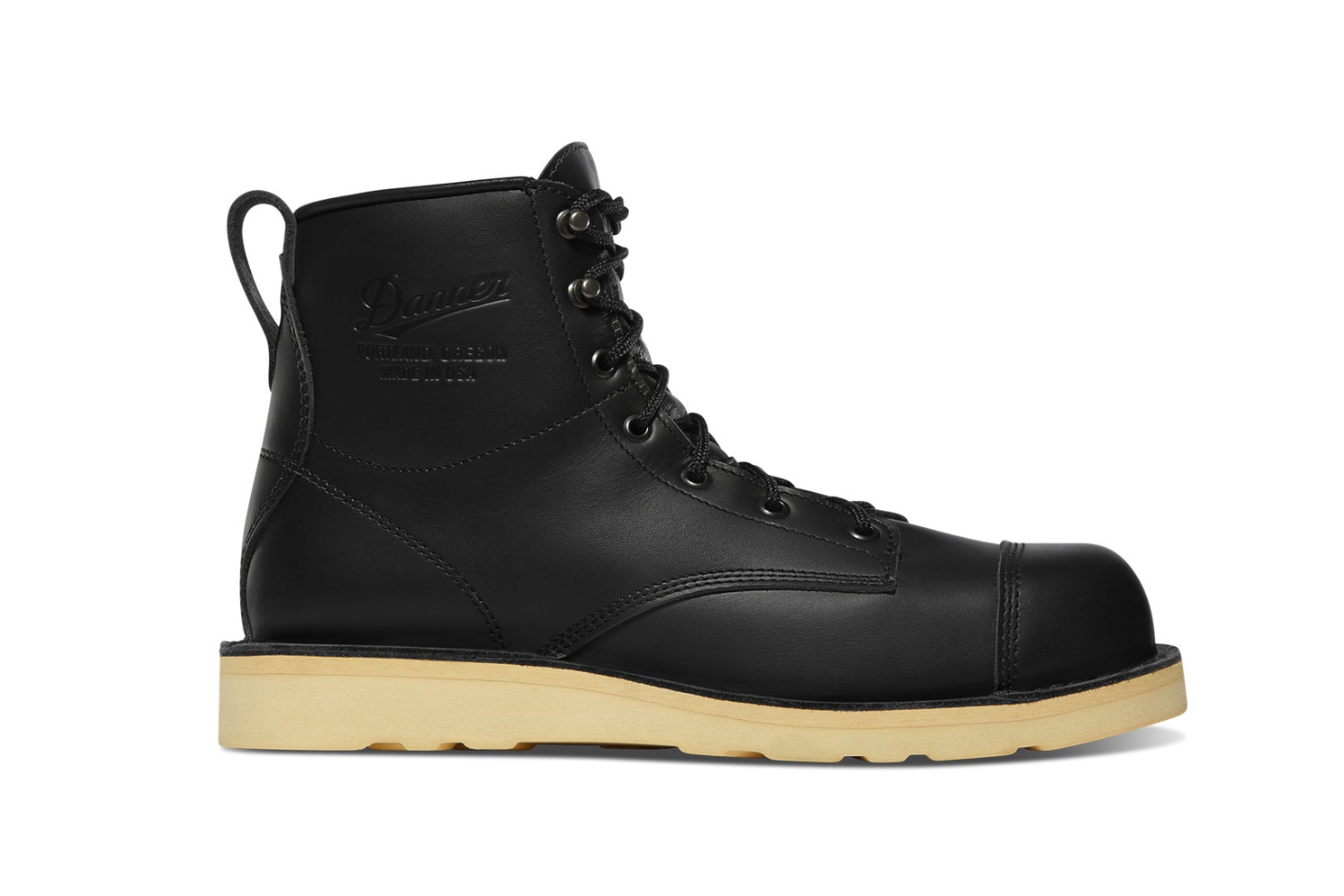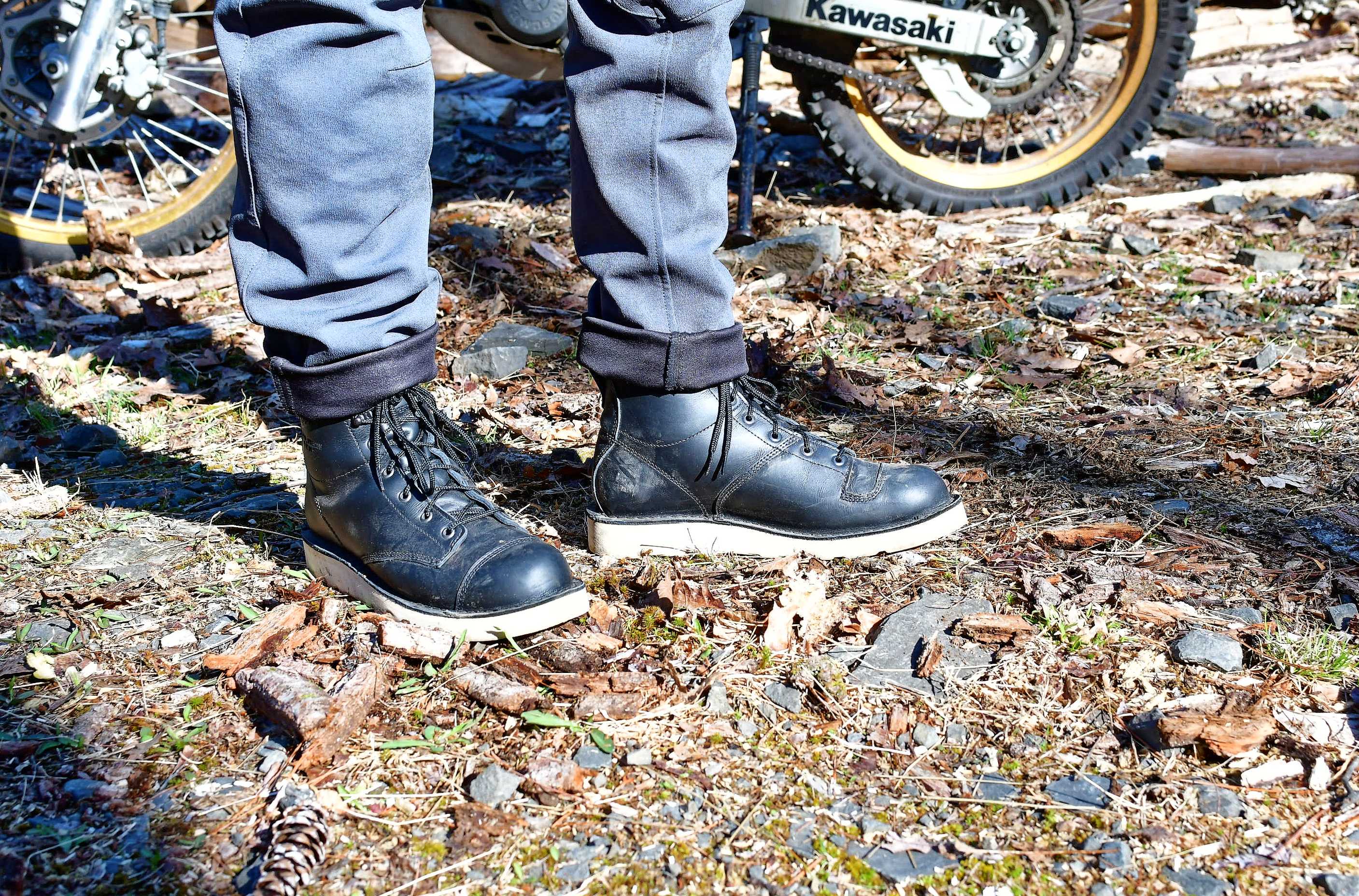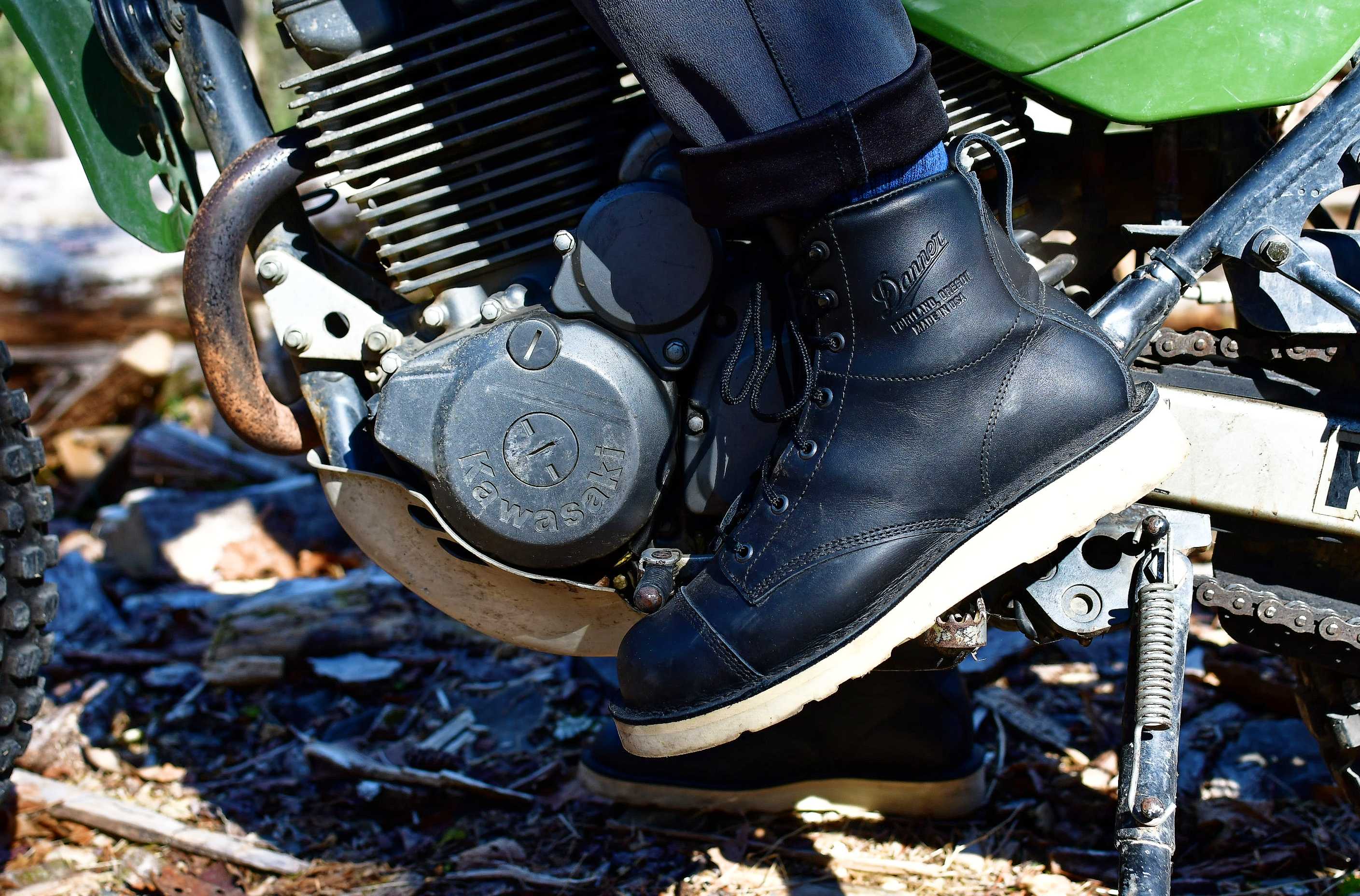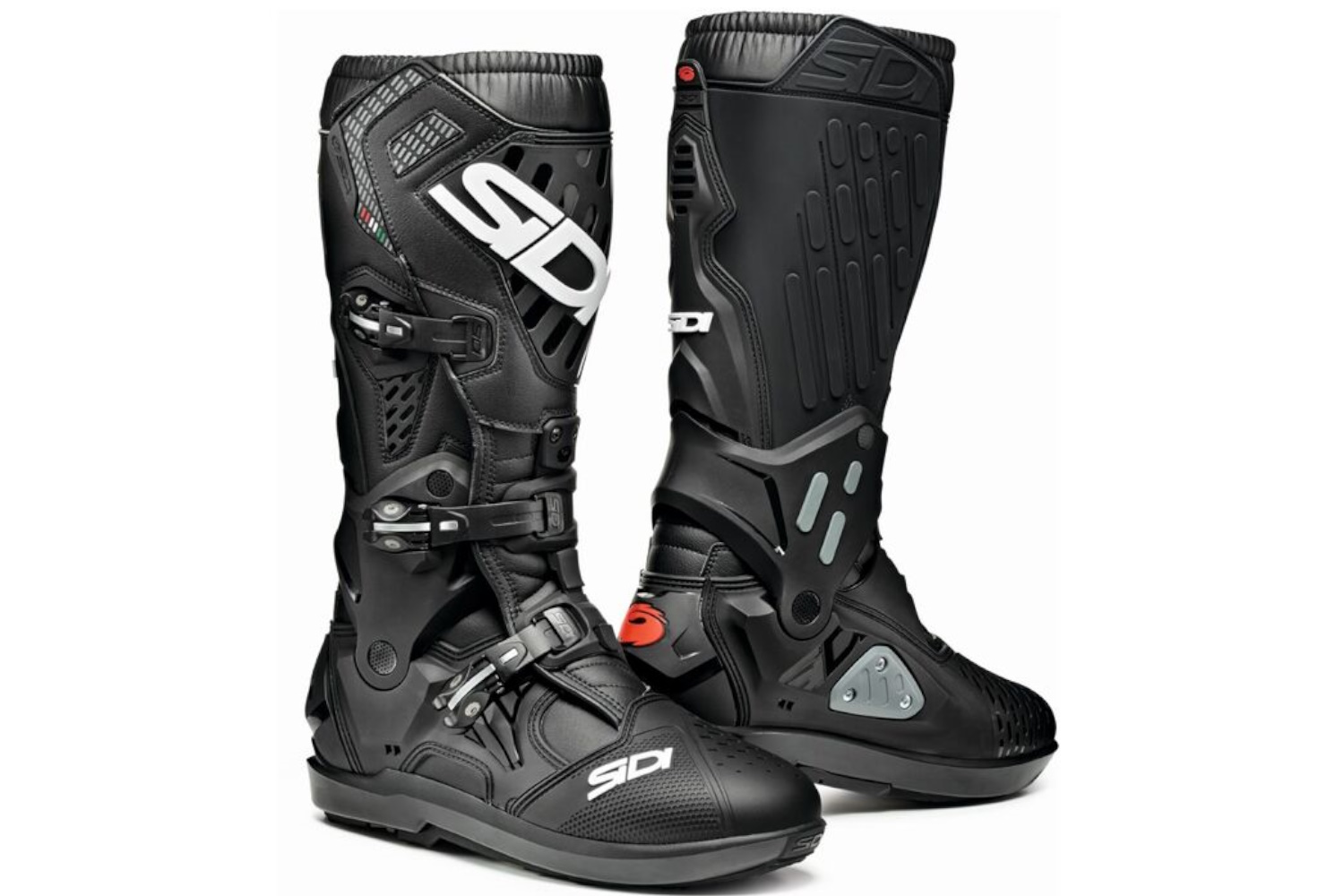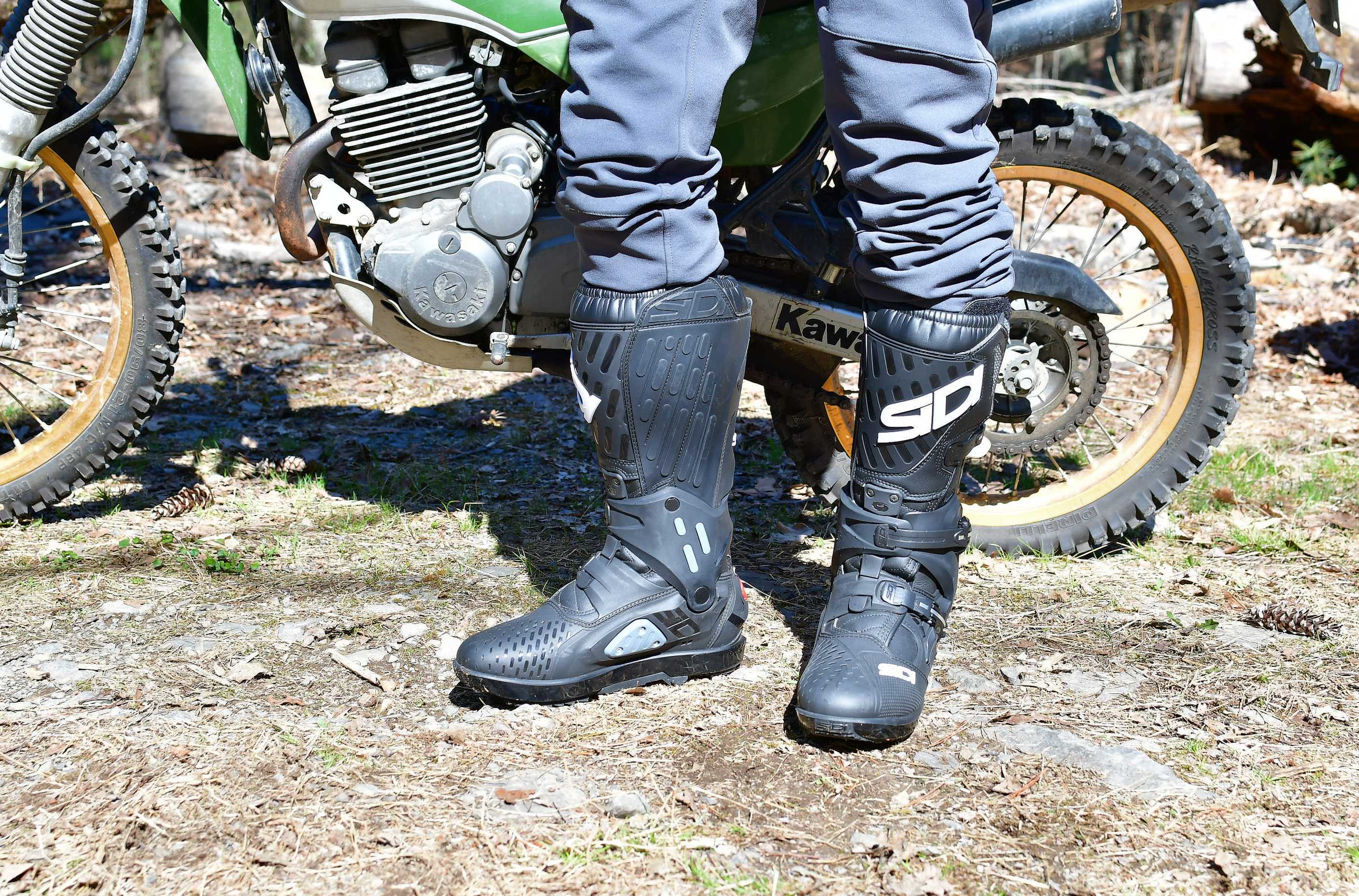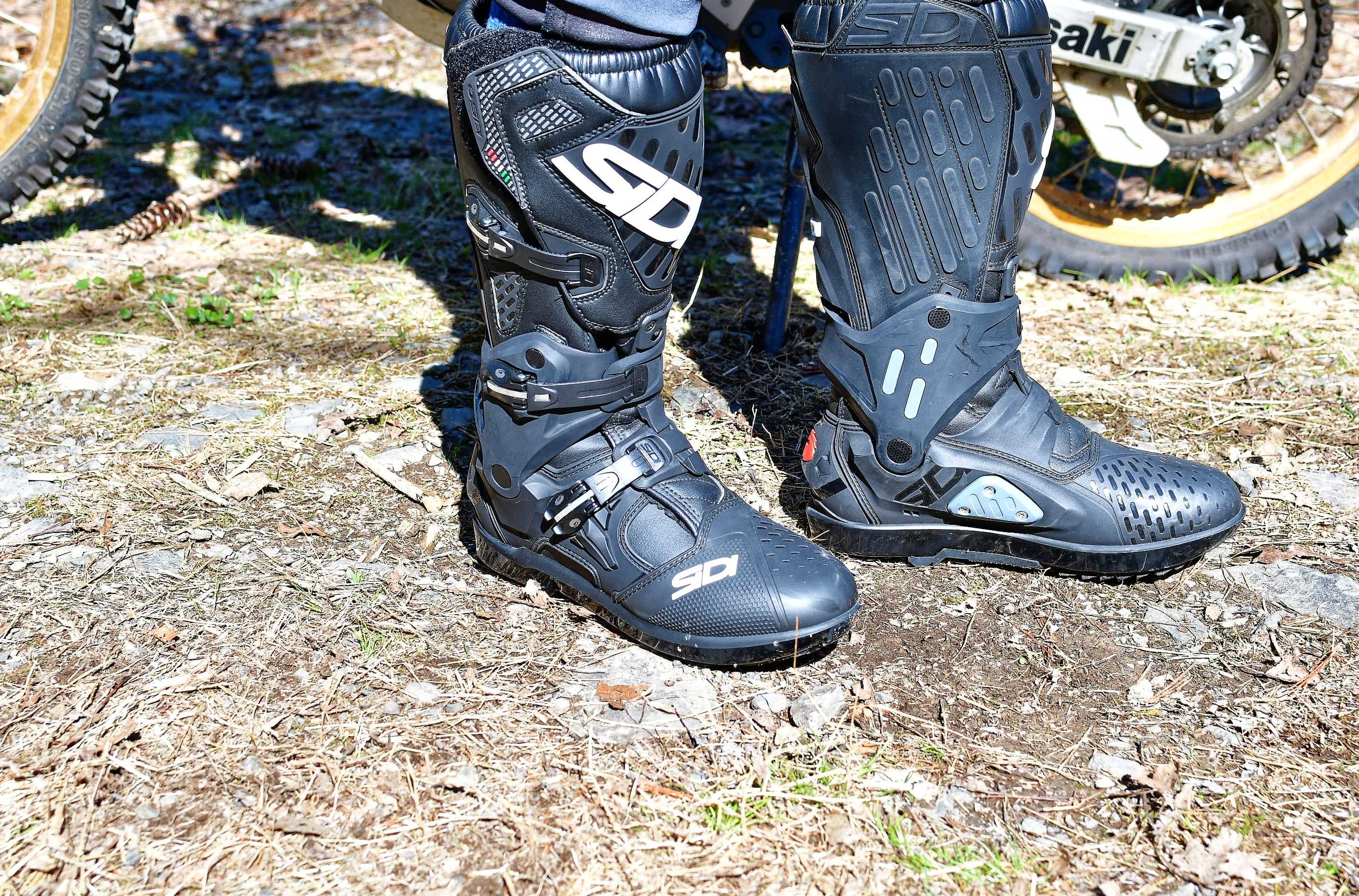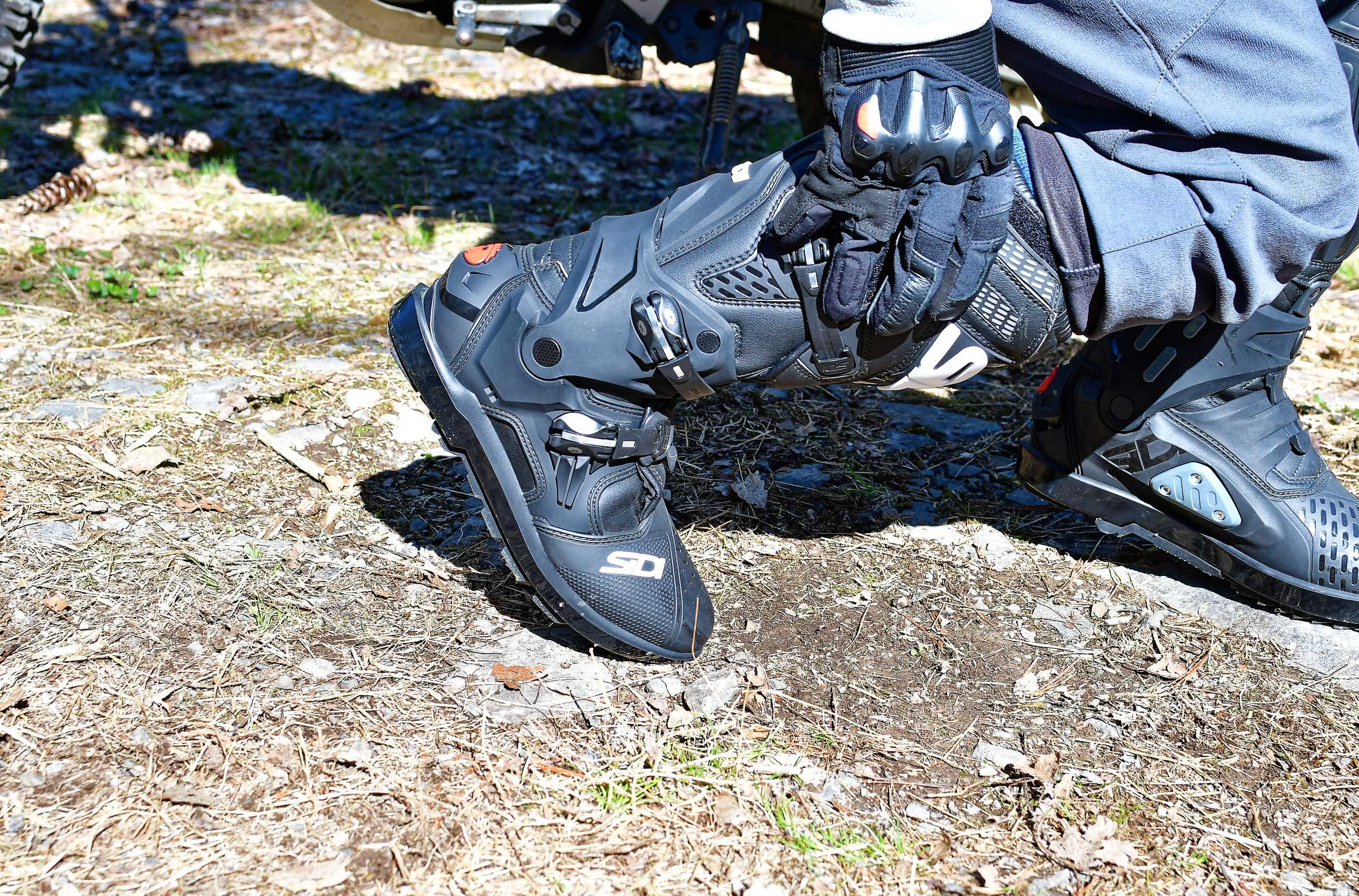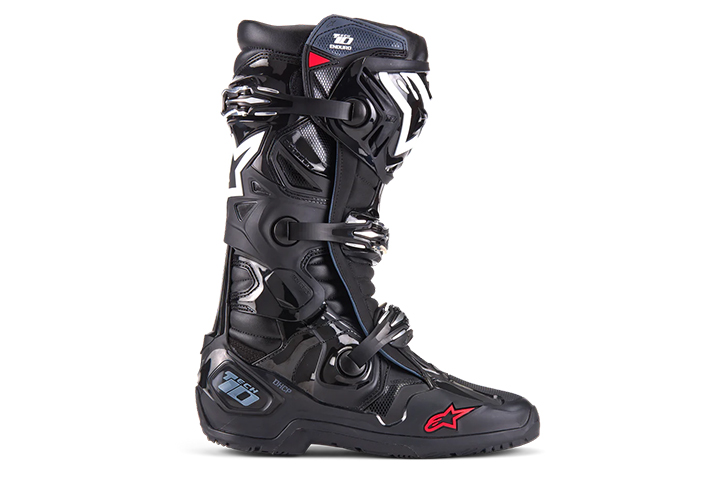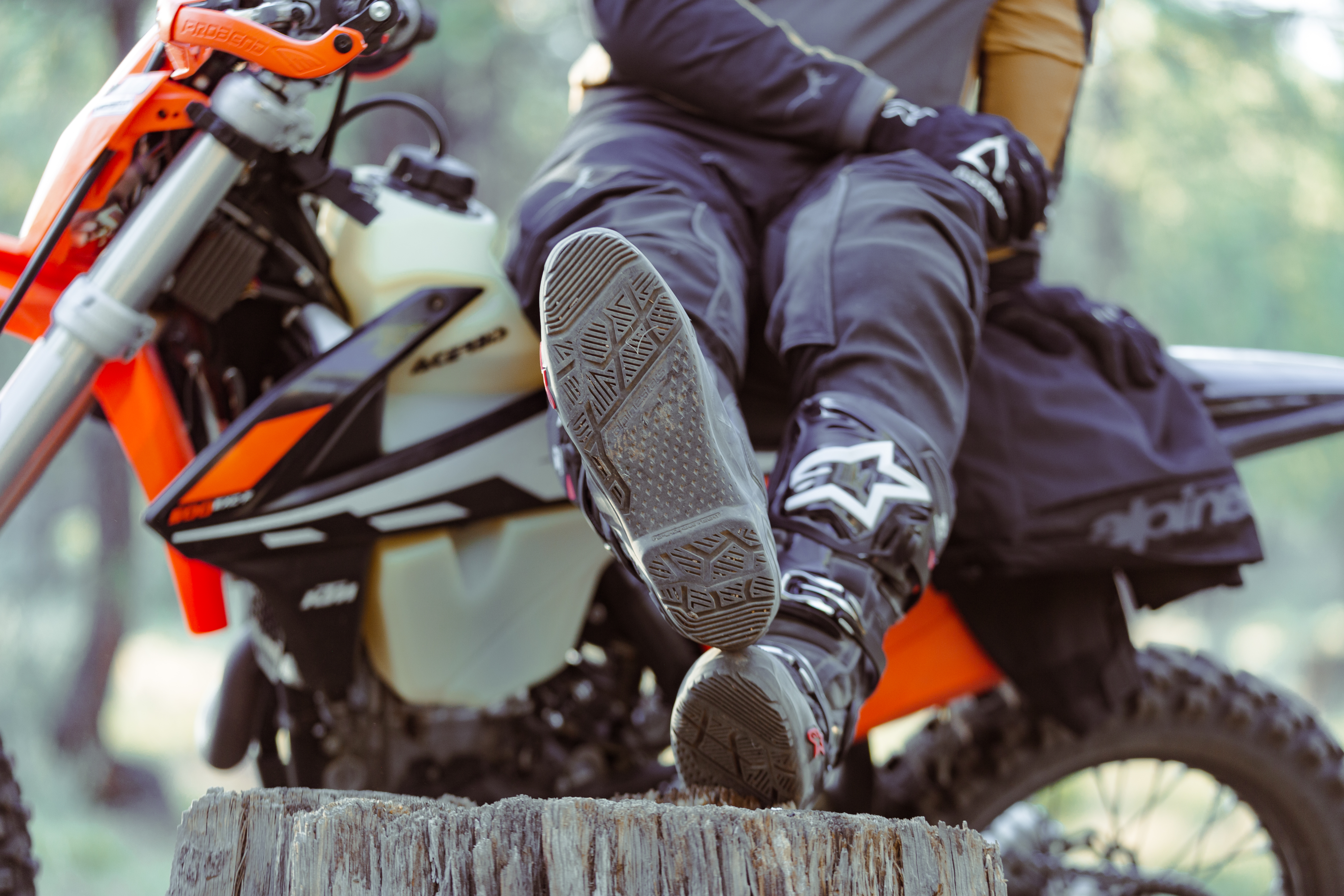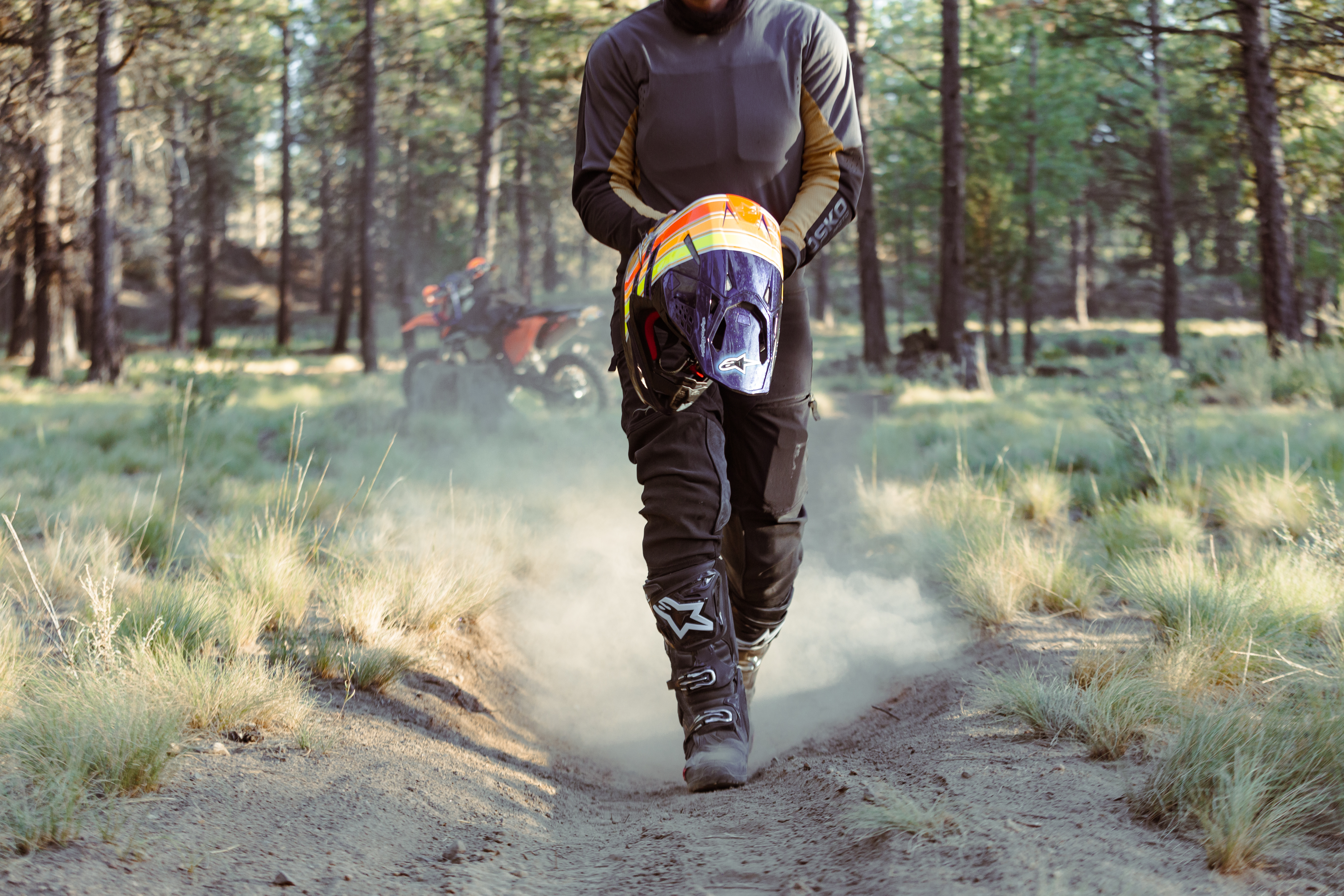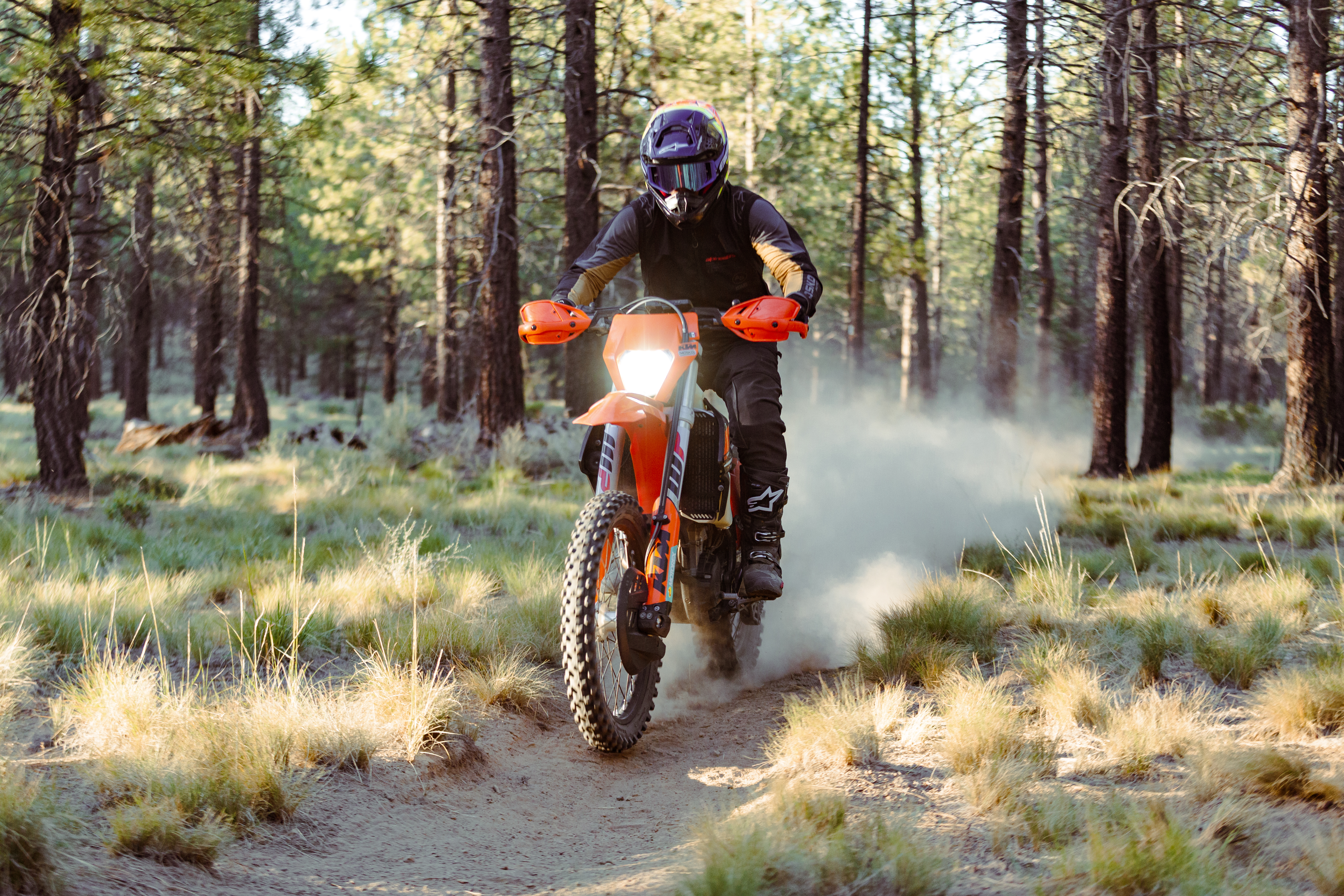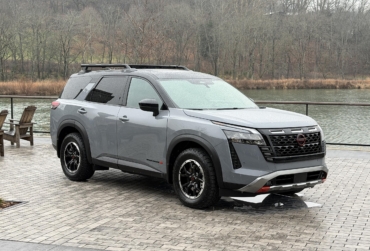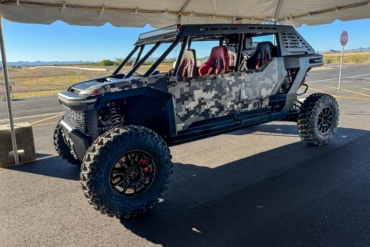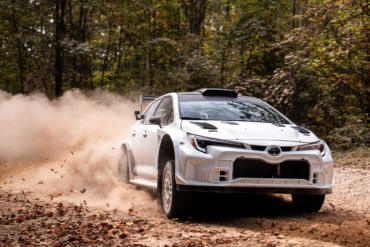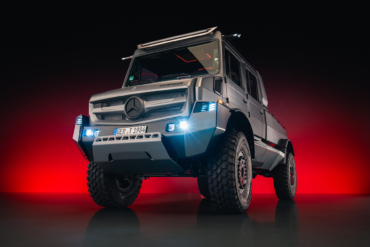Every motorcycle boot has a compromise. Walkability and comfort don’t mesh with maximum protection. But it’s possible to find footwear for riding that’s protective, relatively walkable, and doesn’t look outlandish. That trifecta is the bull’s-eye of this list. Beyond that focus, we wanted to find moto boots that nail comfort.
We skewed this list toward adventure (a.k.a. ADV) motorcycle boots. With some overlap, we also considered city commutes with details like compatibility with pant cuffs for those making quick trips to the grocery store.
Depending on your ride needs, you could be keen to pull on mid-height adventure kicks like the Fox Racing Defend ADV Boots with BOA quick-closure. Or, you might want a taller pair like the waterproof, lightweight TCX Drifter. Otherwise, the Fox Racing Motion X Off Road is geared toward off-road and trail rides, while the adventure-focused Alpinestars Corozal is built for long tours and dual-sport days.
Ultimately, don’t be tempted to ride in a pair of sneakers. We know if gear is uncomfortable or hard to use, it’s more likely to build up dust. So, we found the motorcycle boots we truly love and hope you do, too.
Editor’s Note: We updated our Motorcycle boots buyer’s guide on July 28, 2025, with two field-tested picks: the Alpinestars Tech-10 Enduro and the award-winning Fox Racing Defend ADV Boots, a mid-height adventure boot with the BOA lacing system for quick closure.
The Best Motorcycle Boots of 2025
TCX Drifter
- Materials: Full-grain leather with T-DRY waterproof membrane; polyurethane armor
- Protection: CE Level 2
- Weight: 2.44 lbs.
- Best Use: ADV, daily rides
Pros
- Waterproof membrane
- Rebuildable stitched-down sole
- Comfortable for walking
- Excellent buckle system
Cons
- Not quite as protective as alternatives
REV’IT! Everest GTX
- Materials: Hypalon ripstop with Gore-Tex waterproof membrane, ripstop polyester; laminated armor frame
- Protection: CE Levels 1 and 2
- Weight: 1.58 lbs.
- Best Use: ADV, daily riding
Pros
- Waterproof membrane
- Super lightweight
- Comfortable for walking
- Easy zip closure stays put
Cons
- Not quite as protective as alternatives
Fox Racing Defend ADV Boots
- Materials: GORE-TEX upper, BOA fit system, D30 Impact protection, Ultratec outsole, Microban liner, nylon-fiberglass insole
- Protection: CE Level 2
- Weight: 2.06 lbs.
- Best Use: Off Road, ADV
Pros
- Comfort out of the box
- Extremely versatile
- Excellent durability
- BOA lacing system
Cons
- GORE-TEX can run hot
- Not the tallest boot choice
Fox Racing Motion X Off Road Boot
- Materials: DURATEC compound on treaded outsole and medial side of boot, waterproof membrane, composite nylon fiberglass cuff, hinge, and insole, TPU impact plates, microbial lining
- Protection: CE Level 2
- Weight 2.06 lbs.:
- Best Use: Off Road, ADV
Pros
- Incredible protection
- Waterproof membrane
- Off bike traction
- Replaceable outsole
Cons
- Can run hot
Alpinestars Corozal
- Materials: Full-grain leather with Drystar waterproof-breathable membrane; TPU armor and steel shank at midsole
- Protection: CE Level 2
- Weight: 2.84 lbs.
- Best Use: ADV
Pros
- Highly protective
- Reasonably walkable
- Great buckle system
- Overbuilt ankle
Cons
- Bulkier than alternatives
TCX Street 3 WP
- Materials: Full-grain leather with T-Dry waterproof membrane, D30 and Zplate inserts, with GroundTrax sole and OrthoLite insole
- Protection: CE Level 2
- Weight: 2.4 lbs
- Best Use: City riding, Commuting
Pros
- Sneaker-like design is extremely comfortable on and off the bike
- CE Level 2 rated
- Pricepoint
Cons
- If you need a higher reaching boot, check out other designs
Danner Moto Wedge GTX
- Materials: Full-grain leather with Gore-tex waterproof-breathable membrane; D30 armor and fiberglass shank at midsole
- Protection: Not rated
- Weight: 1.54 lbs.
- Best Use: City riding
Pros
- Supremely walkable
- Waterproof
- Looks like a regular hiker
Cons
- Not CE-rated
More Motorcycle Boots Shielding Our Bedrocks
- Materials: Synthetic suede, polyamide and Teflon; PU armored with anti-hyperextension zones
- Protection: CE Level 2
- Weight: 3.94 lbs.
- Best Use: Motocross, Off-road riding
Pros
- Interlocking layers of armor and motion prevention
- Almost every part is replaceable
- Bomber, unsurpassed protection
Cons
- Tough to walk in or wear off the bike
- Materials: TPU and rubber compound panels, ventilated shin plate, microfiber gater, polymer buckles with aluminum frames, inner bootie
- Protection: CE certified to EN 13634:2017
- Weight: 4.2 lbs
- Best Use: Off Road, Enduro, Trail
Pros
- Top tier protection
- Excellent off bike traction
Cons
- Larger footprint than competitors
- Inner Bootie isn’t for everyone
Motorcycle Boots Comparison Chart
Scroll right to view all of the columns: Price, Materials, Protection, Weight, Best Use.
| Motorcycle Boots | Price | Materials | Protection | Weight | Best Use |
|---|---|---|---|---|---|
| TCX Drifter | $370 | Full-grain leather with T-DRY waterproof membrane; polyurethane armor | CE Level 2 | 2.44 lbs. | ADV, daily rides |
| REV’IT! Everest GTX | $360 | Hypalon ripstop with Gore-Tex waterproof membrane, ripstop polyester; laminated armor frame | CE Levels 1 and 2 | 1.58 lbs. | ADV, daily riding |
| Alpinestars Corozal | $340 | Full-grain leather with Drystar waterproof-breathable membrane; TPU armor and steel shank at midsole | CE Level 2 | 2.84 lbs. | ADV |
| TCX Street 3 WP | $180 | Full-grain leather with T-Dry waterproof membrane, D30 and Zplate inserts, with GroundTrax sole and OrthoLite insole | CE Level 2 | 2.4 lbs | City riding, Commuting |
| Fox Racing Motion X Off Road Boot | $430 | DURATEC compound on treaded outsole and medial side of boot, waterproof membrane, composite nylon fiberglass cuff, hinge, and insole, TPU impact plates, microbial lining | CE Level 2 | 2.06 lbs | Off Road, ADV |
| Danner Moto Wedge GTX | $480 | Full-grain leather with GORE-TEX waterproof-breathable membrane; D30 armor and fiberglass shank at midsole | Not rated | 1.54 lbs. | City riding |
| SIDI Atojo SRS | $550 | Synthetic suede, polyamide, and Teflon; PU armored with anti-hyperextension zones | CE Level 2 | 3.94 lbs. | Off-road riding |
| Alpinestars Tech 10 Enduro | $740 | TPU and rubber compound panels, ventilated shin plate, microfiber gater, polymer buckles with aluminum frames, inner bootie | CE certified to EN 13634:2017 | 4.2 lbs | Off Road, Enduro, Trail |
| Fox Racing Defend ADV Boots | $345 | GORE-TEX upper, BOA fit system, D30 Impact protection, Ultratec outsole, Microban liner, nylon-fiberglass insole | CE Level 2 | 2.06 lbs. | Off Road, ADV |
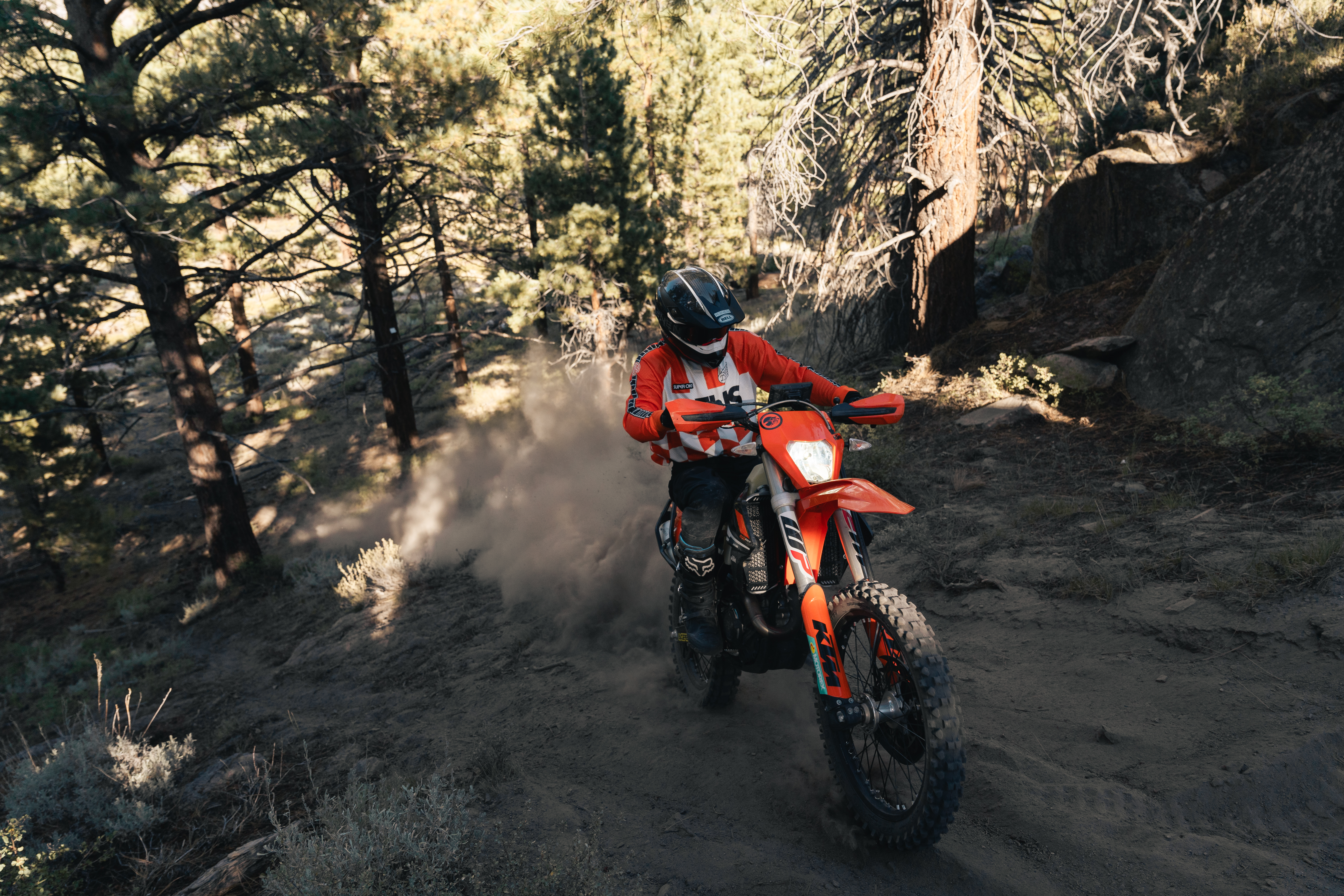
How We Tested Motorcycle Boots
For this motorcycle boots guide, we focused on off-road boots, adventure (ADV) boots, commuter boots, and touring boots.
Our Expert Testers
Sean Galaway contributed to this guide as a tester and reviewer. In addition to countless hours riding enduro, Galaway has several cross-continental ADV trips under his belt. He tested for over 10,000 km across the Trans European Trail, technical single track at home in the Eastern Sierra, and wide open double track in Oregon and Baja California. The boots were put through their paces, from testing waterproofness on Baja beaches to walkability on the cobblestone streets of Istanbul and Prague.
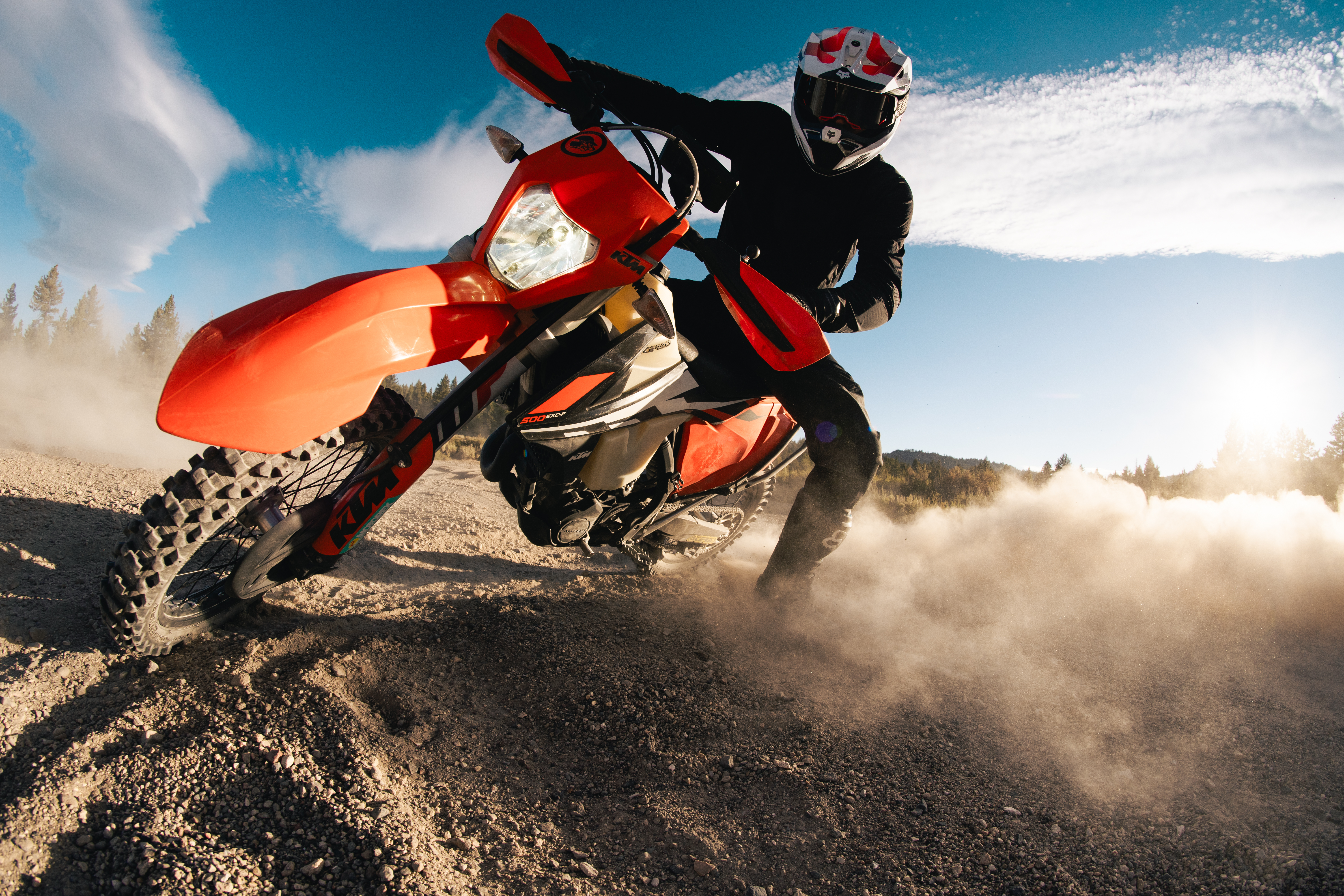
Tester and reviewer Michael Frank evaluated the bulk of these boots over the course of a year. He rode a handful of different bikes on backwoods trails and open highways while putting these boots through the paces. Luckily — for you, not for him — his 2001 Kawasaki died a few times. While push-starting the bike, Frank learned the very hard way how important boot walkability can be. We also sauntered into coffee shops to see how walkable these boots are.
GearJunkie reviewer Hilary Arthur has been riding in a well-worn pair of TCX Street 3 Lady WP for more than seven years. This summer, she donned the new 2024 model for a 1,100-mile Colorado tour. From high alpine passes to Labor Day traffic jams and all the cute mountain towns in between, a versatile boot made all the difference on and off the bike.

Our Testing Grounds
Broadly, our testing focus was versatility for terrain and conditions. We looked for commuter boots that provide enough sensation for continuous shifting through urban zones. Outsoles’ adhesion on wet pavement was key. We also looked for boots with exterior material that could handle the engine heat and protect our interior calf.
Our Testing Process
Function was king. We searched for boots that we could pull on and remove with relative ease. We also checked for strong buckles that stayed put, no rub points, and comfortable midsoles for walking across variable terrain.
While aesthetics are subjective, you won’t find loud colors or racing styles here. We aimed to find boots with a more timeless, everyday look.
All motorcycle boots have compromises. Fully waterproof boots tend to ride hotter, and heavily armored boots are also toasty. We cut out some options that didn’t meet our metrics and honed in on the boots that would work for most riders most of the time.
Buyers Guide: How to Choose the Best Motorcycle Boots
There are a lot of subcategories of motorcycle boots. The right boot for your riding depends on the kind of terrain you tackle for most of your rides.
When you check out the racks, you’ll find boots for touring/cruising, motocross (MX), racing/track, adventure/dual sport, sport touring, and riding footwear, which is generally shorter.
Here are the categories we cover in this guide:
- Off-Road Motorcycle Boots: These boots, like the Fox Racing Motion X Off Road, generally combine motocross-level protection with a treaded sole for off-bike traction. They can be used for a variety of disciplines, from trail riding to enduro to ADV.
- ADV Boots: ADV boots, like the TCX Drifter or Alpinestars Corozal, provide a great combination of protection and off-bike walkability. These often have waterproof inserts and a grippy outsole, too.
- Touring Motorcycle Boots: Boots like the REV’IT! Everest GTX blur the lines between an ADV boot and a touring boot, making them great options for mostly road-based long rides. These boots typically lack the buckle closure found in off-road, motocross, and burlier ADV boots.
- Motocross Boots: These boots offer the pinnacle of protection, as shown in the burly build of the Sidi Atojo SRS. With their smooth outsoles and overbuilt protection, these boots are made for riding, not for walking.
- City Motorcycle Boots: The Danner Wedge GTX offers great style, walkability, and much more protection than your standard casual boot, making it a great representative of this category of boots.
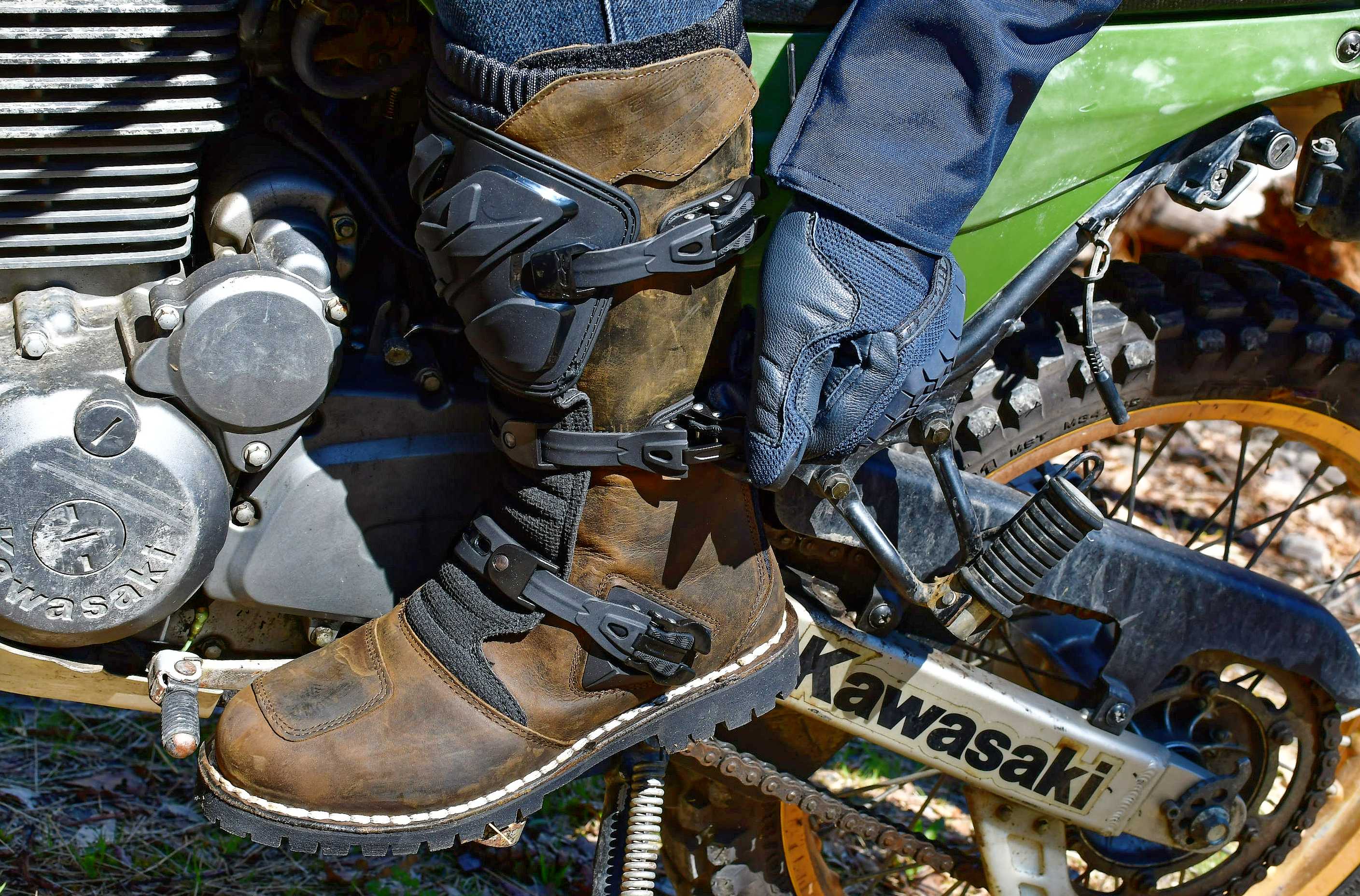
Parts of Motorcycle Boots
When you try on motorcycle boots at the store, think about the following details:
Buckles or Closure System
You don’t want a buckle to pop open on a ride, so pay attention to that in the store.
Buckles should be easily adjustable and stay shut once the cam spring is closed. That’s one reason we love the TCX Drifter and the Fox Racing Motion X Off Road.
We see under designed buckles more than we wish. A safe, protective boot needs to stay clasped when you ride, while loading or picking up your bike, and if you crash. Our favorite buckles are made of durable metal and are replaceable if they do break.
Alternatives to buckle closures are slip-on (which we don’t prefer in a crash), boa closures (which are becoming more popular in the ADV category), and, of course, laces for the most casual and least protective applications.
When it comes to more casual styles like the TCX Street 3 WP, the closure systems are often laces rather than buckles. This shoe has an integrated elastic loop at the tongue to tuck your laces into. We thought this was a nice feature to reduce the potential for a snag hazard and keep them from whipping in the wind.
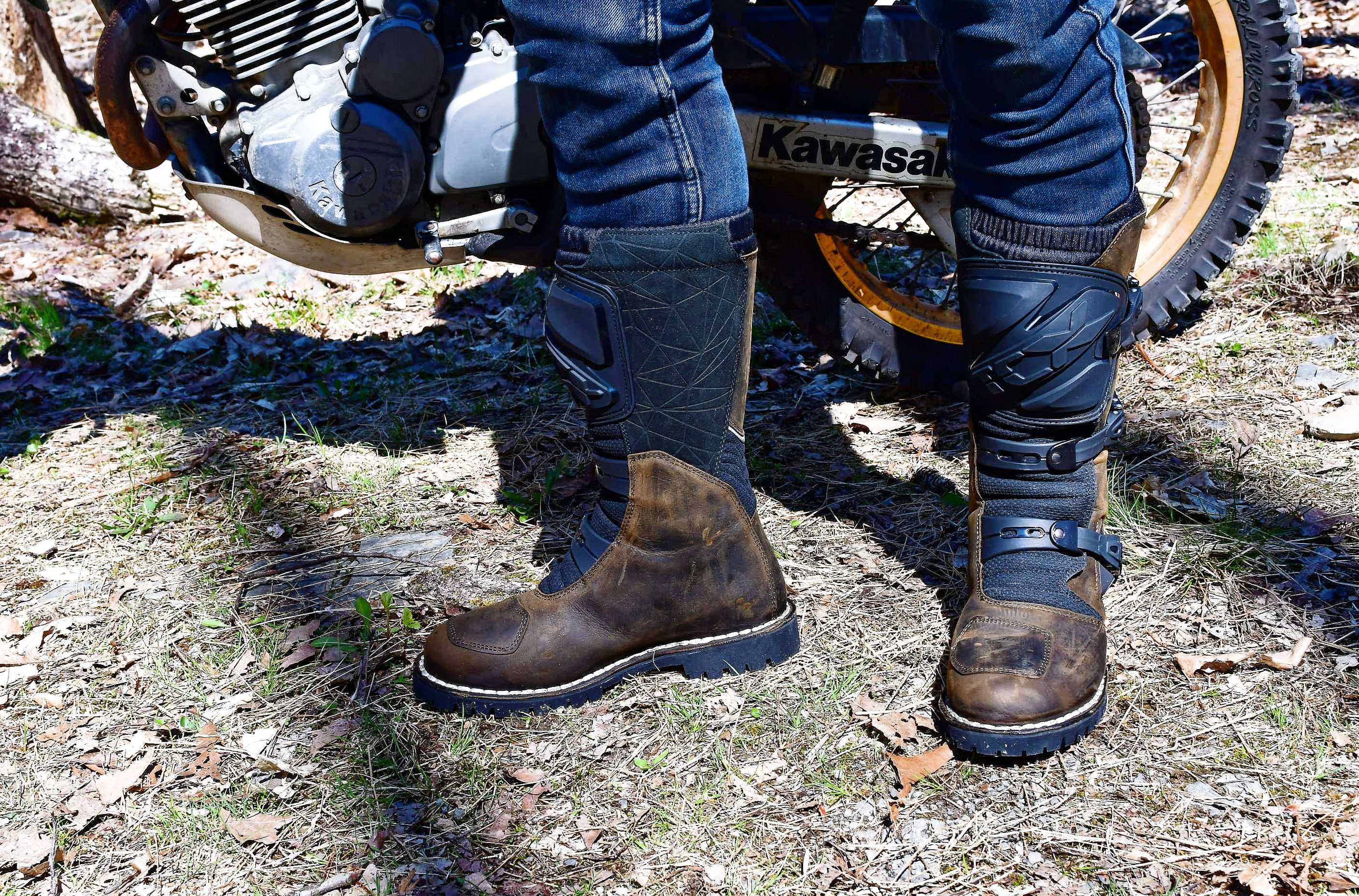
Reinforcement
Boots should be built to make riding more safe and intuitive. Here’s a look at some of the protective elements that you should key in on when making a purchase:
- Toebox: The toebox should not collapse. A boot that strikes a balance between protection against impact and while shifting is key. Boots that offer protective but low-profile construction for easy shifting are ideal.
- Heat Protection: Taller boots should have adequate heat protection on the medial side of the boot. These are typically made of rubber composite materials, like Fox Racing’s DURATEC compound, or a leather material that won’t burn against exhaust pipes or the engine.
- Ankle protection: Burlier boots have composite nylon-fiberglass cuffs and/or flex-lockout or hinge systems to provide mobility and protection for the ankle and Achilles from hyperextension and twisting.
- Shin-Protection: We like taller boots with TPU plating on the shins, heels, and other high-impact parts of the ankle. This design will pay dividends during impacts and slides.
- Foot Protection: Most boots have a reinforced insole design to protect your foot from injury in case of an impact or crash. These are typically made from a composite nylon-fiberglass material that balances rigidity with light weight.
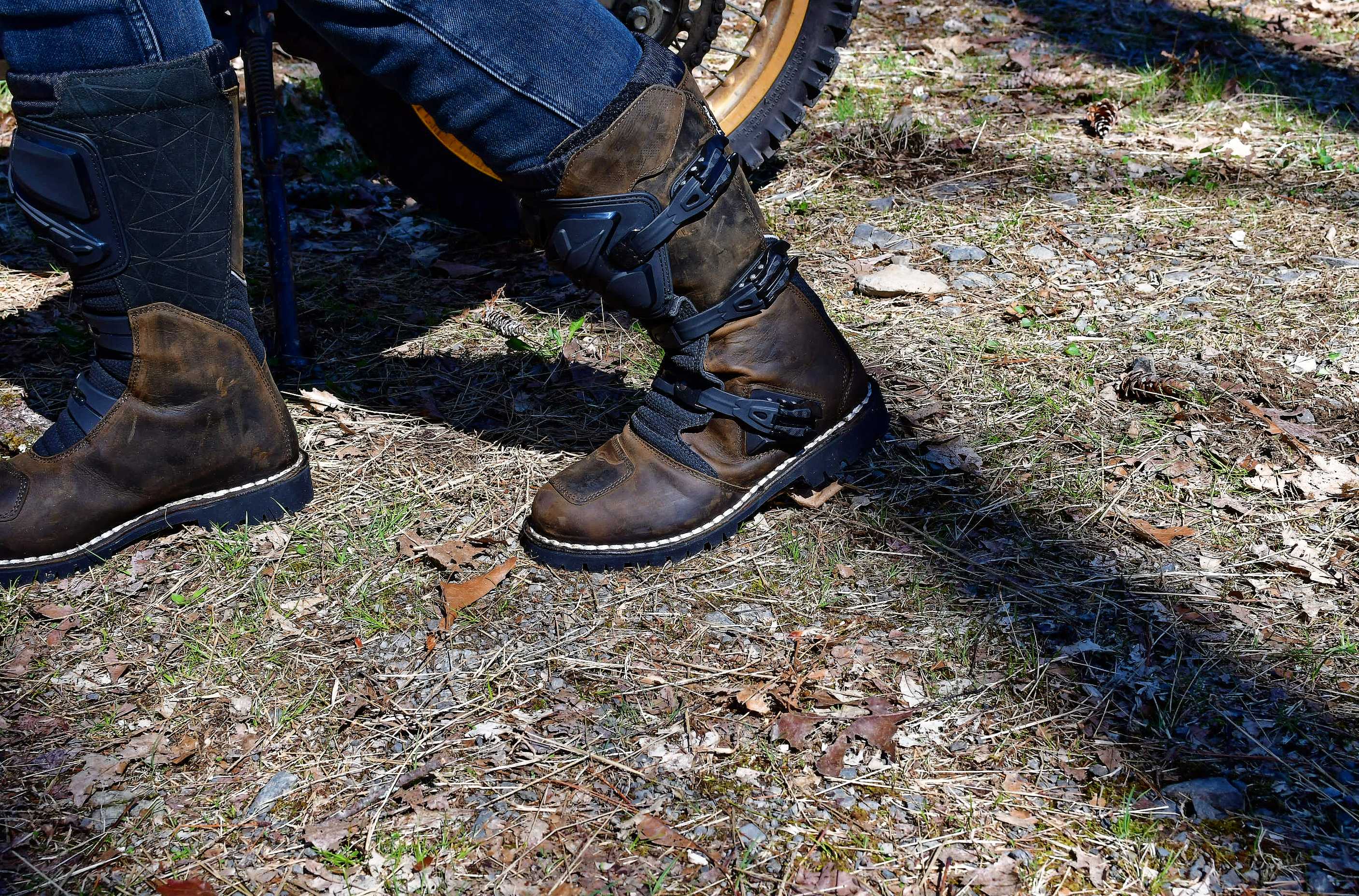
Outsole
To choose the best outsole, consider when you ride and on what kind of terrain. Smooth outsoles like those on the Danner Moto Wedge GTX work fine on the street but aren’t great on dirt. Unpaved sections need lugged soles, which offer more grip and are handier for hiking sections of trail.
Gaiter or Cuff
Waterproof systems are pretty common in motorcycle boots but pointless if rain rolls down your pant leg and into your boot. Ideally, your pants or rain gear will fit over the top of your boot. But if they don’t, a snug cuff closure is key.
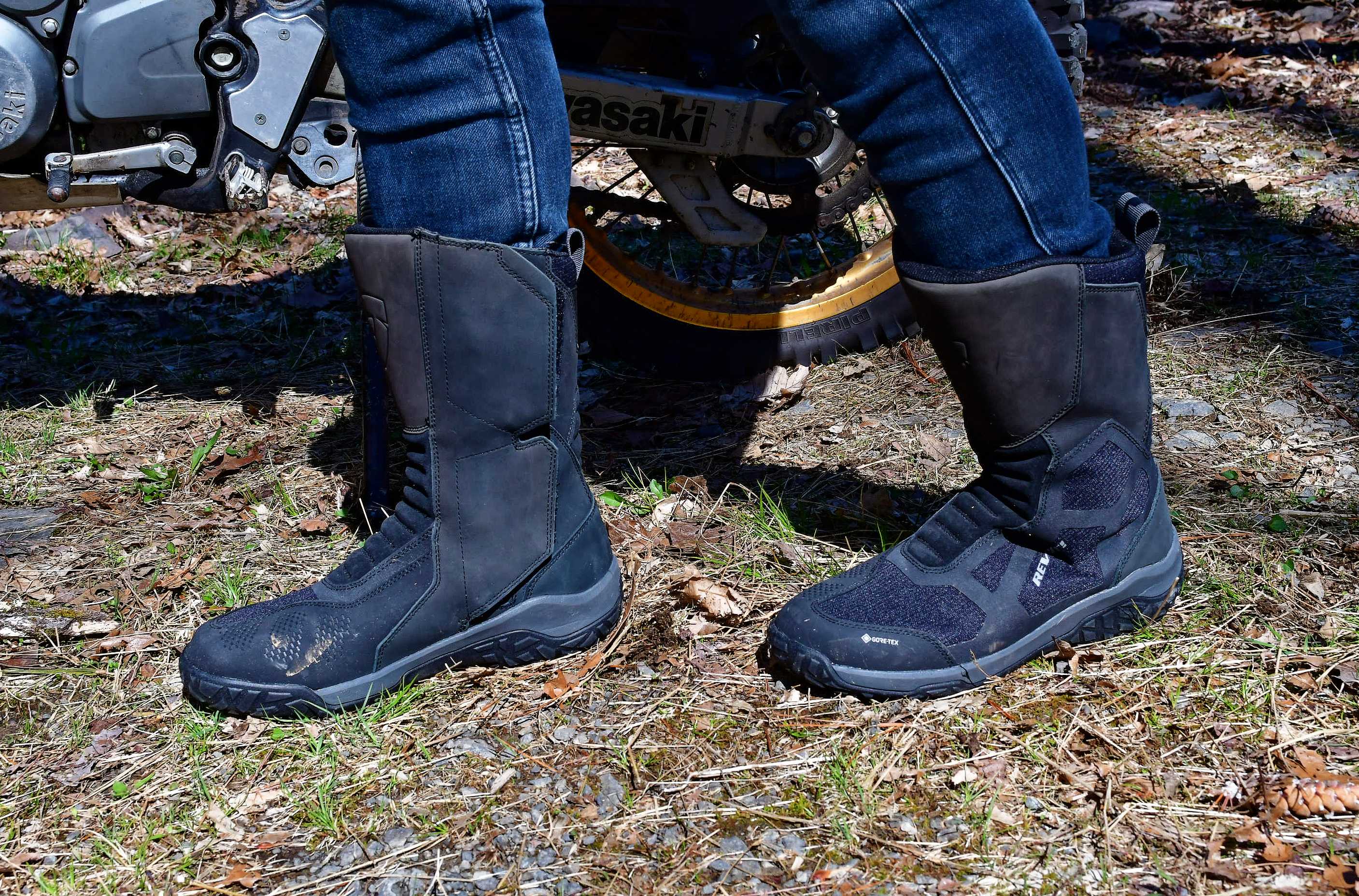
Materials & Weight
Heavier motorcycle boots are built for a specific application. For instance, the Sidi Atojo SRS is an amazing choice for riding very technical terrain. The build is lighter than SIDI motocross footwear, but they are also three times heavier than the REV’IT! Everest GTX.
CE safety ratings don’t account for weight, but we pay attention because the grams influence comfort.
On the materials front, synthetics tend to be lighter than leather. You’ll find synthetic boots that meet the same CE rating as leather boots, too. Leather lasts longer and is more resistant to grease and road grime than synthetics.
The weaker and cheaper points of boots tend to be the clasps, closures, and buckles. The TCX Drifter hits the center of the target for material and weight. They’re not ultra-lightweight but are a bit less hefty than the Alpinestars Corozal. The high-wear zones are built with leather, and weight-saving synthetic materials are used where you need a greater range of motion.
When you consider materials, think about the type and specific location on the boot. Also, consider where you’ll be riding whether that’s down the street or through the Chilean Andes.
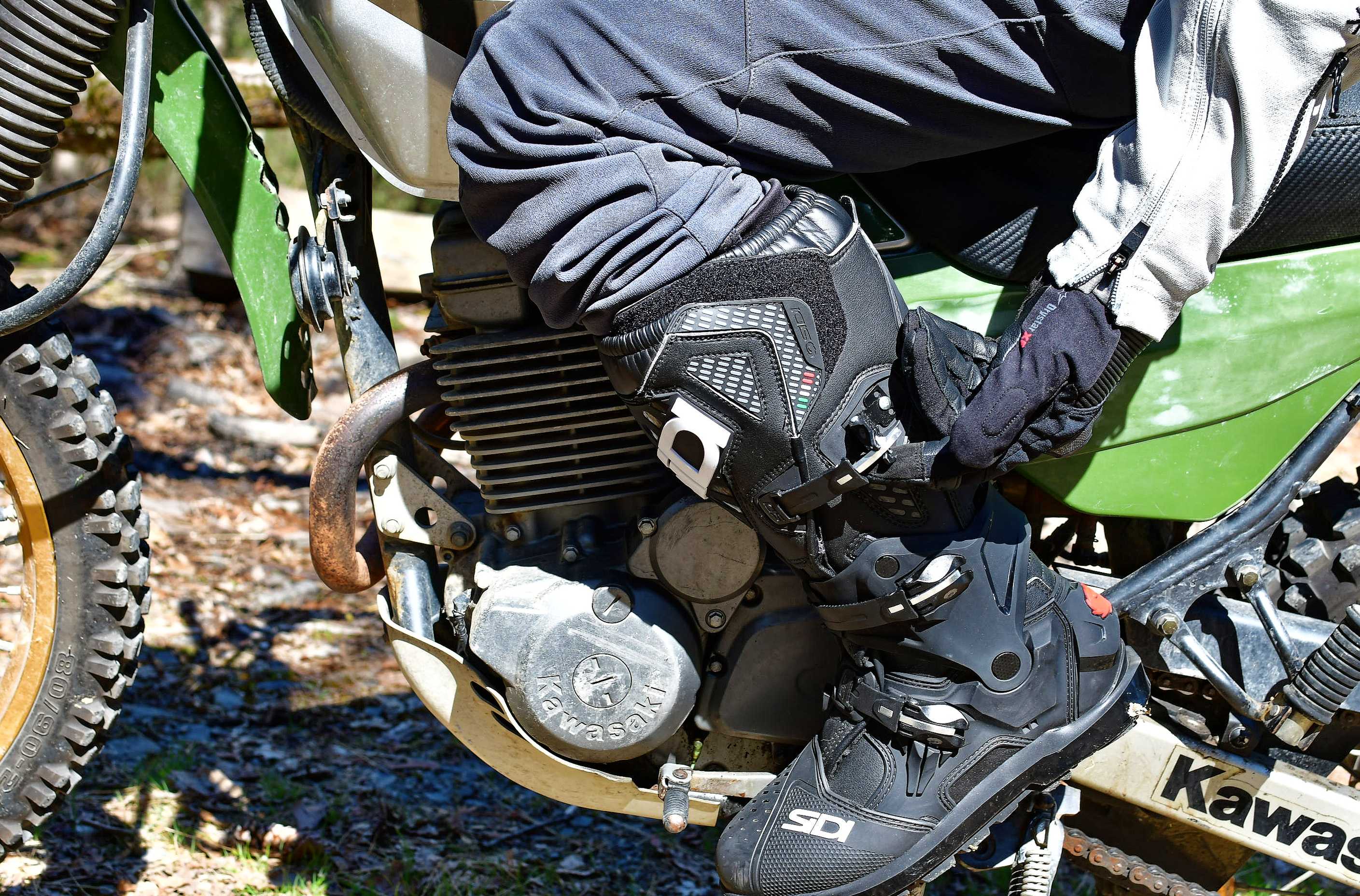
Waterproofing
Motorcycle boots made with a waterproof-breathable membrane dominate this list. To point, the Danner Moto Wedge GTX low-top boot incorporates Gore-Tex. With a shorter boot, the inside of the footwear might still get soaked unless you were wearing a waterproof gaiter. The REV’IT! Everest GTX is taller, which is a better choice if wet weather is a concern.
Another taller boot with a gaiter-like closure is the Alpinestars Corozal or the TCX Drifter.
What’s the downside of truly waterproof boots? They don’t breathe as well, so they can get hot.
Overall, if you’re really concerned about getting wet, be sure that the interface between your motorcycle pants and your motorcycle boots is compatible and well-sealed.
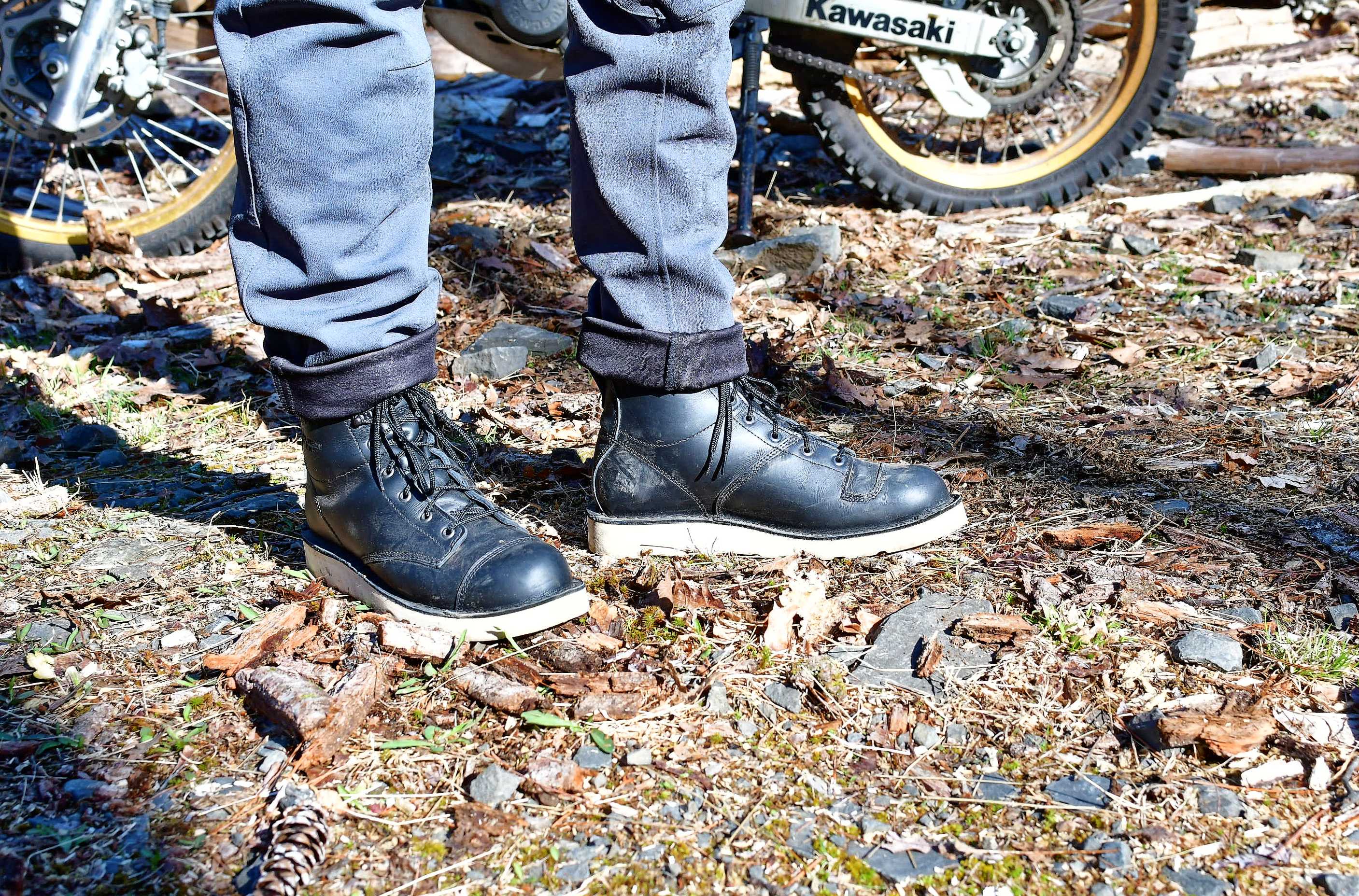
Safety Certifications & Crush Protection
The European Union rates the armoring and slide protection of motorcycle boots. These fall within CE (Conformité Européene) Level 1 and 2 standards. The EU measures the sole, front, and back of the boot, and the lateral components. They also measure abrasion and crush resistance.
For abrasion, the EU uses a tool like a belt sander. A boot that scores a Level 1 needs to withstand 1.5 seconds against the belt without forming a hole on the sole, front, or back. A Level 1 resistance for the sides of a boot needs to resist for 5 seconds against the belt sander. (Because you’re more likely to slide sideways in an accident.)
Meeting the Level 2 certification is more stringent. A boot’s front, back, and sole needs to withstand 2.5 seconds against the belt without developing a hole. The inner and outer soles need to survive 12 seconds of contact with the belt.
The boots are also tested for crush protection, also known as transverse rigidity. This is important because when riders step off the bike their trusty steed occasionally falls on their foot. Two plates are pressed against the boot’s sole to try to smash it. The boot needs to withstand a force that’s equivalent to at least 214 pounds of pressure to meet Level 1 standards, and the boot can deform very minimally. The rate is 337 pounds for the Level 2.
The EU doesn’t test crush protection at the ankle bone or the toebox. Though, both of those are very vulnerable zones that you should consider during the purchase process. You’ll find decent ankle protection in the REV’IT! Everest GTX. There’s more ankle protection in the TCX Drifter, and even better toe and ankle protection in the Alpinestars Corozal.
You’ll find protection around your entire lower leg with the Sidi Atojo SRS and Fox Racing Motion X Off Road.
For a city shoe that meets CE Level 2 quality, you can’t go wrong with the TCX Street 3 WP. TCX achieves this high rating by integrating D30 armor into the ankle and boot, as well as ZPlate technology to stiffen the sole laterally, but maintain comfort and walkability.
The Danner Moto Wedge GTX offers a very rigid sole, so it might pass a Level 1 for crush-proofness in the CE test, and there’s some armoring at the ankle bone, too.
Women’s Motorcycle Boots
Properly fitted footwear is key, especially since we use our feet for important controls and stability on a motorcycle. Women’s footwear designs will start at a lower size range than men’s, opening up options for those with smaller feet. That being said, if you fall within a range that can also wear men’s sizing, feel free to try unisex boots as well to find the right features and fit for your needs.
Our female reviewer wears a women’s size 7.5 but struggles with the narrow width that many women’s boots have. That’s why we love the TCX Street 3 Lady WP, which has ample width in the toebox, and is a fully lace-up design to allow for maximum fit customization throughout the boot.
You definitely don’t want a boot that’s too tight and restricts blood flow to your extremities or compromises comfort while off the bike. On the flip side, if you have a narrower foot, make sure you’re not swimming in the boot you choose.
Price & Value
Budget
On the lower end for price, you’ll find designs like the TCX Street 3 WP ($180) with a lower height, so they inherently require less material to create. Despite that, this boot is made of full-grain leather, and without a taller neck, there’s no impact protection that extends higher. The protection of this boot is verified through additional certifications like the CE Level 2 stamp on this pair.
Mid-Tier
The majority of our favorite motorcycle boots fall in this zone, in the $300 range. The Alpinestars Corozal ($340), for instance, has full-grain leather with Drystar waterproof-breathable membrane plus TPU armor and steel shank at the midsole, so you’ll notice a step up in protection.
Premium
On the high-price end, you’ll find the beefiest, most built-out construction. Take the SIDI Atojo SRS ($550): This boot has synthetic suede, polyamide, and Teflon, plus it’s PU armored with anti-hyperextension zones. This is a great option for touring and long-distance highway road trips. But a super built-out boot isn’t the priority for all riders. If you prefer a boot with a bit more give and flexibility, like for dual-sport bikers, check out a more flexible design that’s still protective.
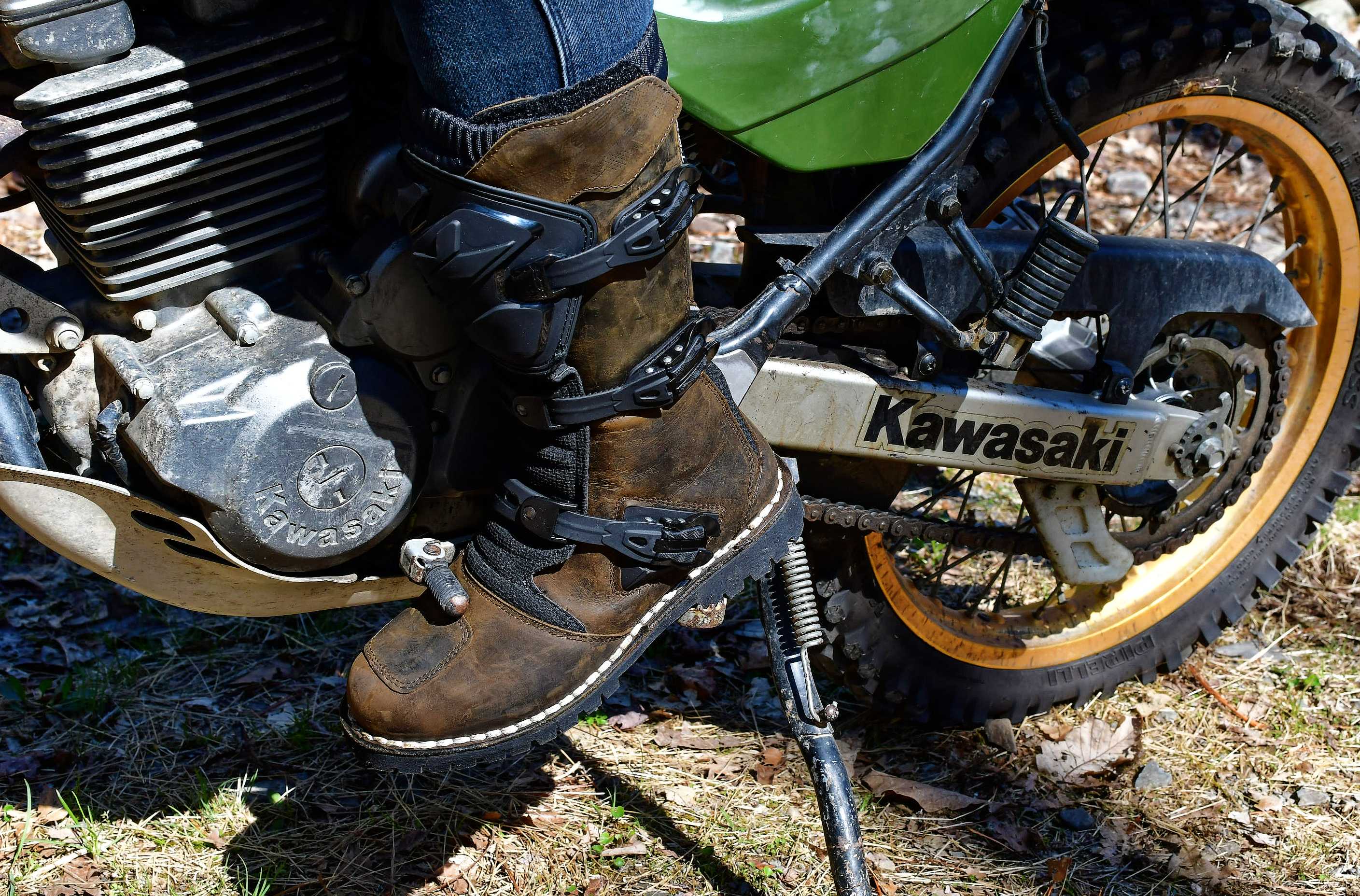
Frequently Asked Questions
There’s no single answer to this question.
The outsole shouldn’t be able to twist or be crushed from the side. The outsole should be able to withstand friction. You’ll also want protection from the heat of the motorcycle against your inner leg and from hot pavement. A good boot should be reinforced at the ankle and at the top of the left boot to protect from the wear caused by shifting.
A couple of our favorite motorcycle boots include the TCX Drifter and the Alpinestars Corozal.
Yes. Riding is dangerous and it’s dangerous to your extremities.
Motorcycle boots provide crush protection, especially during one of the most common accidents: having the bike fall on you at a stop or while dismounting.
Moto boots are also built to last, because they’re constructed with durable materials. They’re going to resist damage, and can sometimes be repaired with new parts.
The initial investment pays dividends when you consider the injury prevention and repairable construction, so you’re not replacing them year after year.
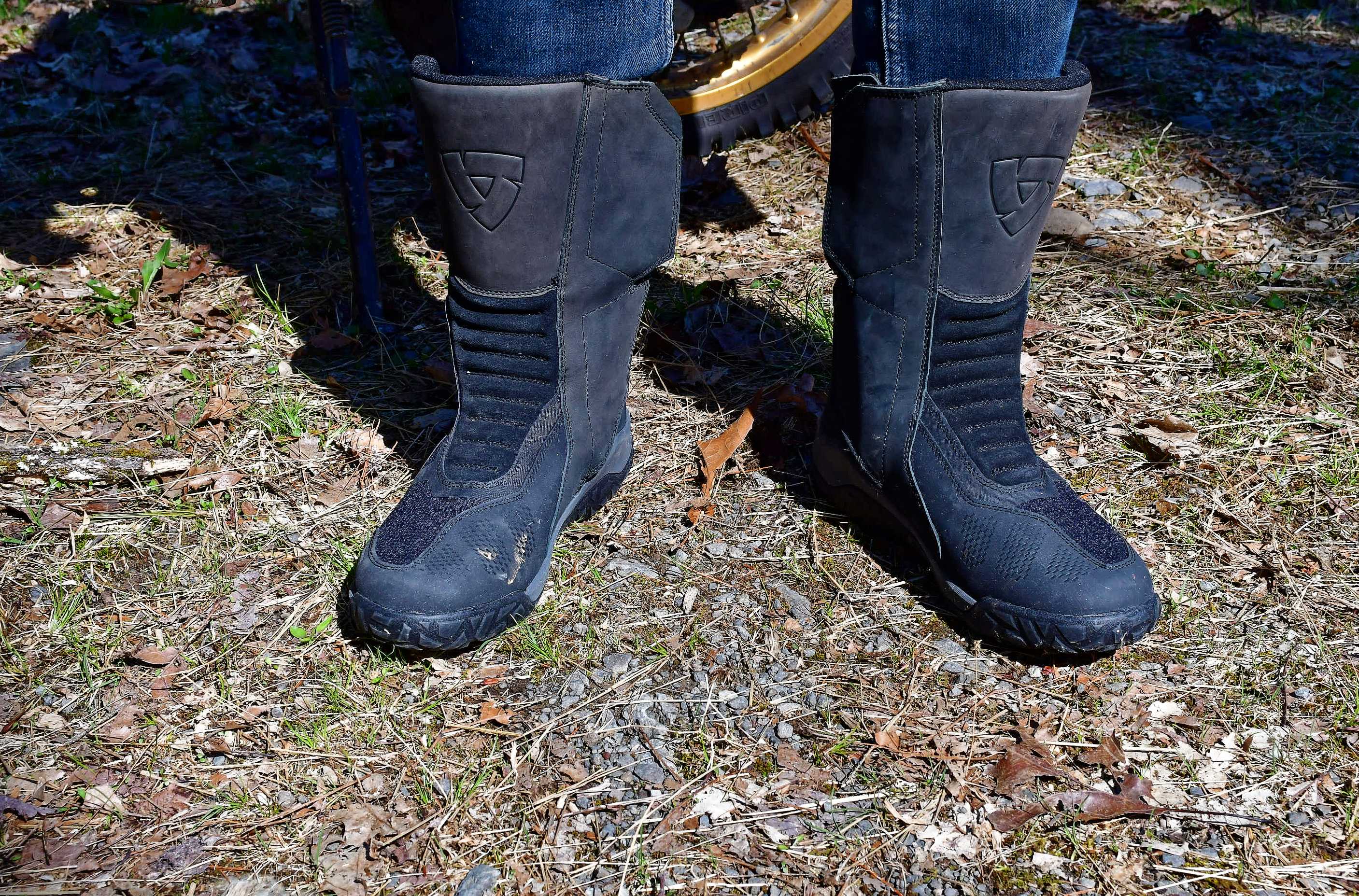
There’s zero doubt here: You want a snug motorcycle boot. However, they shouldn’t cut off circulation.
Choose a boot that you can comfortably wear for many hours without pain. But a loose fit will alter the protection. A boot should be able to prevent hyperextension or an ankle roll.
The boot will also need to withstand the extra weight and force from your leg anchored against the ground, which is what stops a bike from rolling backward.
Hands down, if you are riding technical and off-road terrain, shin protection is a must-have.
For city riding, sport touring, and commuting, it comes down to personal and safety preferences. A higher boot is going to be hotter, less comfortable to walk in, and often more expensive than an ankle boot. However, the added protection in a slide or impact may be worth it. If your preferences lean more toward casual style, opt for a CE-rated low boot that you feel comfortable in. The most important part is picking safe gear that you will actually want to wear.
Although we might be stating the obvious, all riding footwear should include protection up to your ankle bone at the very least.
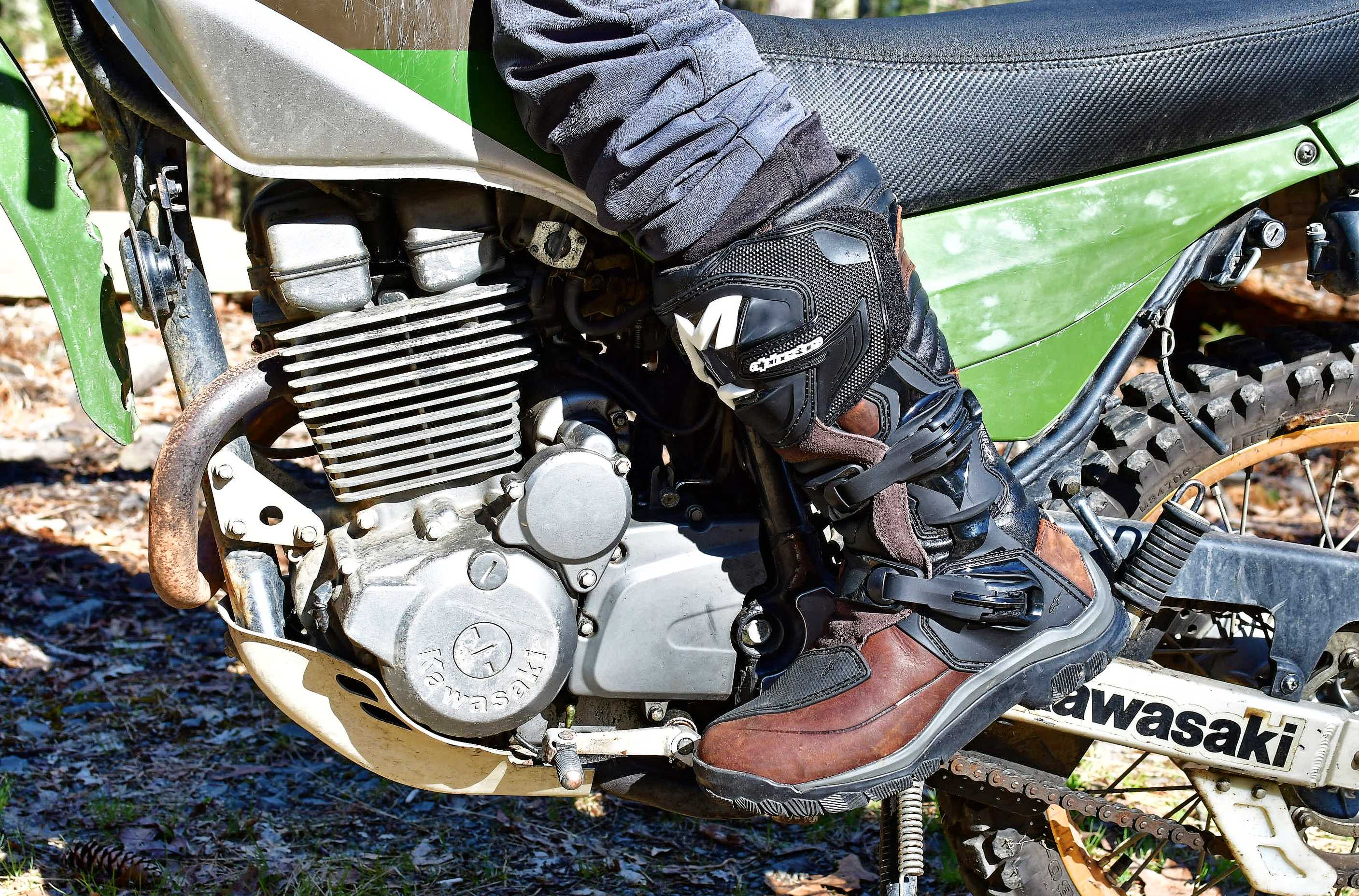
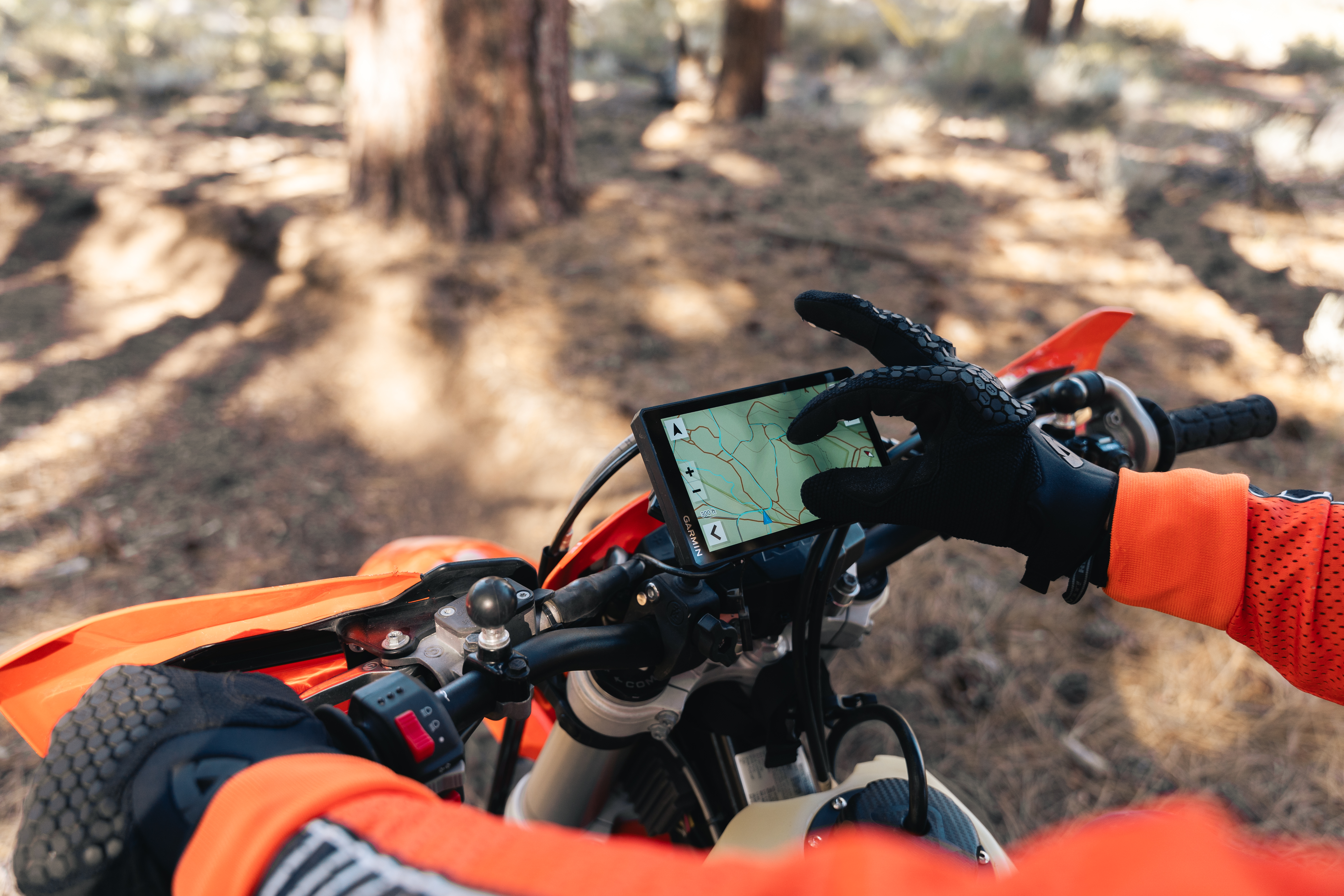
The Best Motorcycle Gloves of 2025
Excellent motorcycle gloves are grippy, supportive, and protect your hands. Our favorite tested pairs include Dainese, Alpinestars, REV’IT and more.

The Best Motorcycle Helmets of 2025
We tested the top motorcycle helmets to find the safest, most comfortable lids for adventure, tour, street, and commutes. Check out our favorites from Bell, KLIM, and more.
